ERP Systems in the Cloud: Advantages, Disadvantages, and Case Studies
VerifiedAdded on 2023/06/08
|20
|5657
|212
AI Summary
This report discusses ERP systems in the cloud, including on-premises and hosted ERP systems, and practical examples of cloud ERP systems. It outlines the advantages and disadvantages of both ERP systems and cloud computing, and provides case studies of companies using ERP systems.
Contribute Materials
Your contribution can guide someone’s learning journey. Share your
documents today.
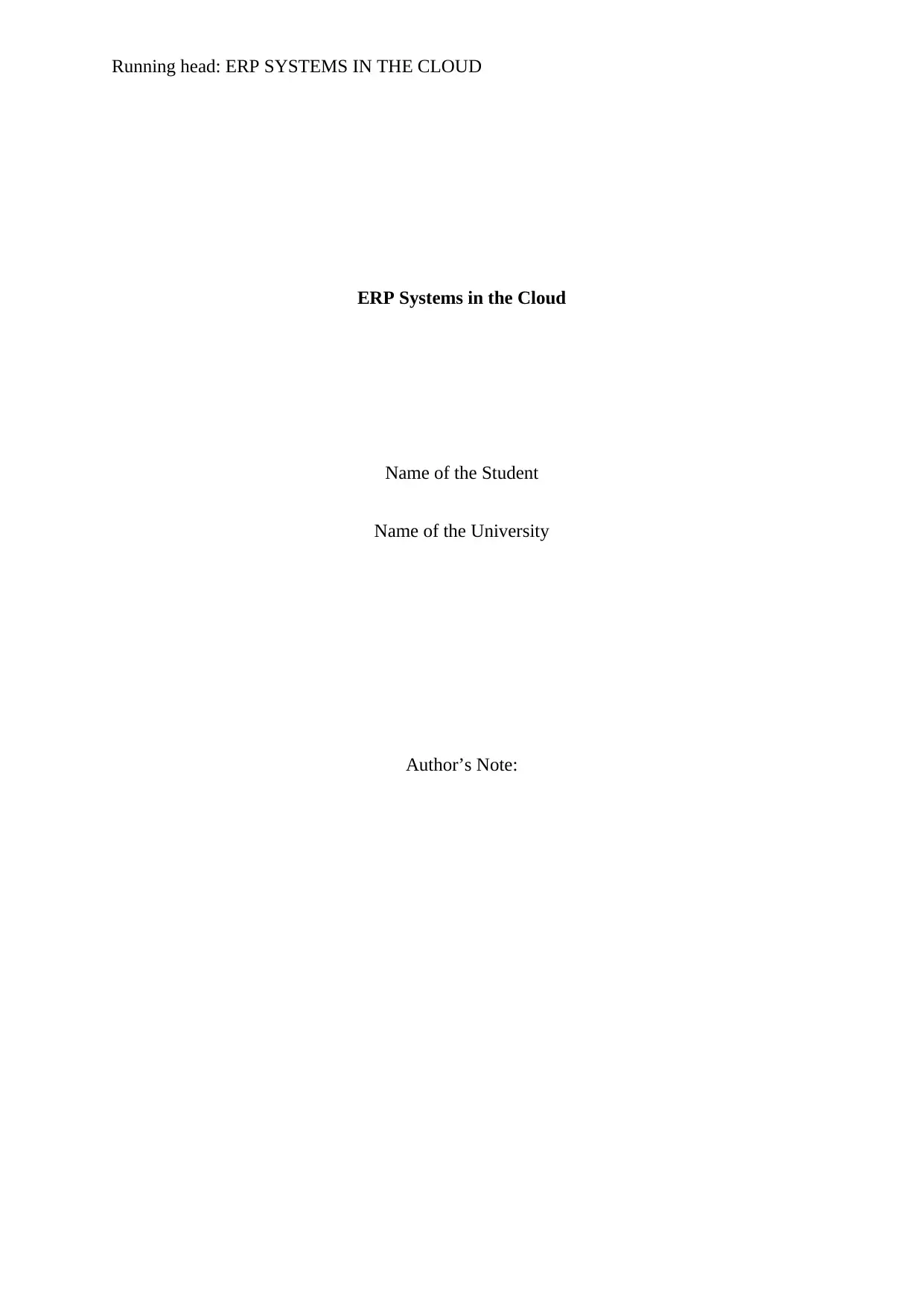
Running head: ERP SYSTEMS IN THE CLOUD
ERP Systems in the Cloud
Name of the Student
Name of the University
Author’s Note:
ERP Systems in the Cloud
Name of the Student
Name of the University
Author’s Note:
Secure Best Marks with AI Grader
Need help grading? Try our AI Grader for instant feedback on your assignments.
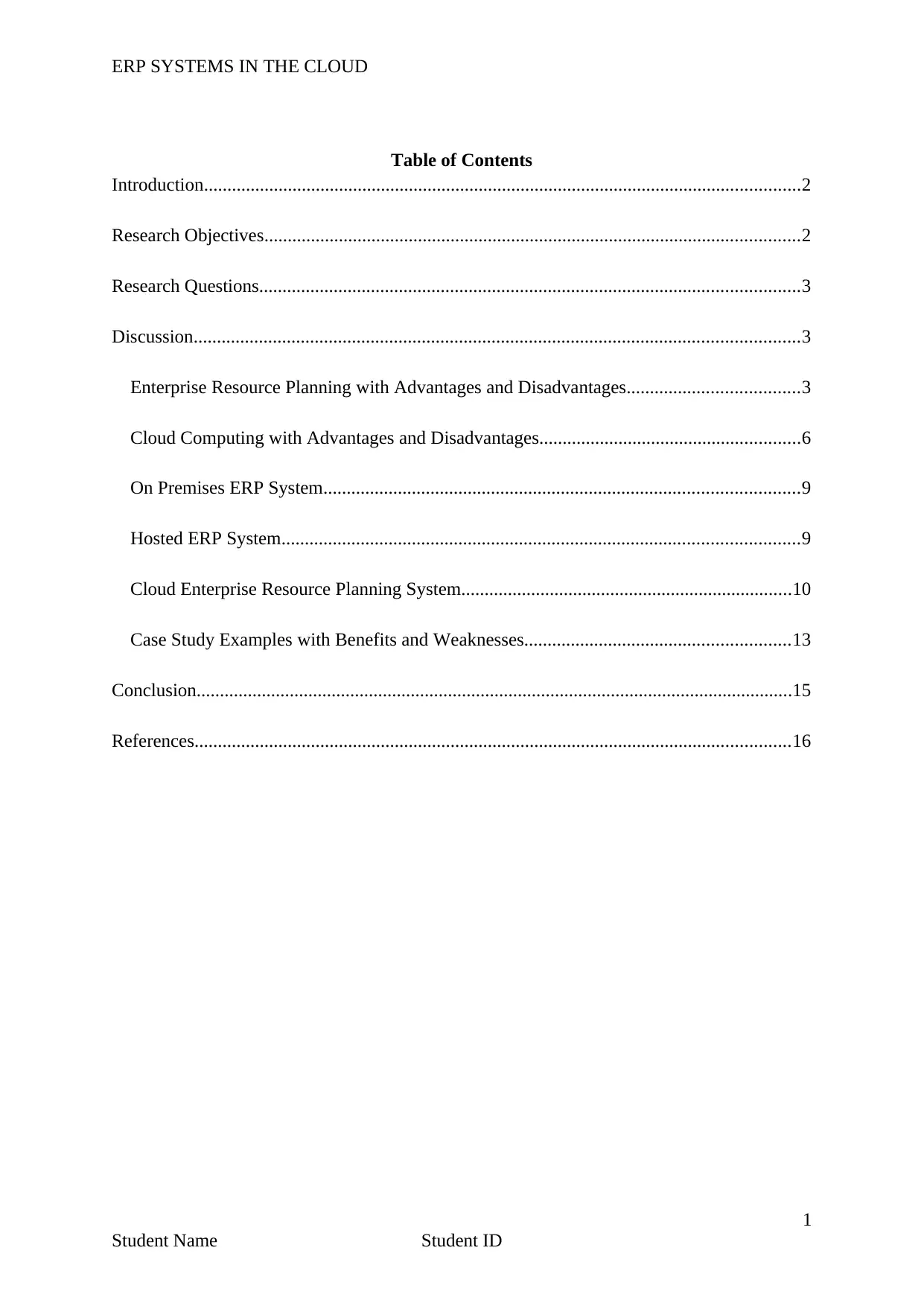
ERP SYSTEMS IN THE CLOUD
Table of Contents
Introduction................................................................................................................................2
Research Objectives...................................................................................................................2
Research Questions....................................................................................................................3
Discussion..................................................................................................................................3
Enterprise Resource Planning with Advantages and Disadvantages.....................................3
Cloud Computing with Advantages and Disadvantages........................................................6
On Premises ERP System......................................................................................................9
Hosted ERP System...............................................................................................................9
Cloud Enterprise Resource Planning System.......................................................................10
Case Study Examples with Benefits and Weaknesses.........................................................13
Conclusion................................................................................................................................15
References................................................................................................................................16
1
Student Name Student ID
Table of Contents
Introduction................................................................................................................................2
Research Objectives...................................................................................................................2
Research Questions....................................................................................................................3
Discussion..................................................................................................................................3
Enterprise Resource Planning with Advantages and Disadvantages.....................................3
Cloud Computing with Advantages and Disadvantages........................................................6
On Premises ERP System......................................................................................................9
Hosted ERP System...............................................................................................................9
Cloud Enterprise Resource Planning System.......................................................................10
Case Study Examples with Benefits and Weaknesses.........................................................13
Conclusion................................................................................................................................15
References................................................................................................................................16
1
Student Name Student ID
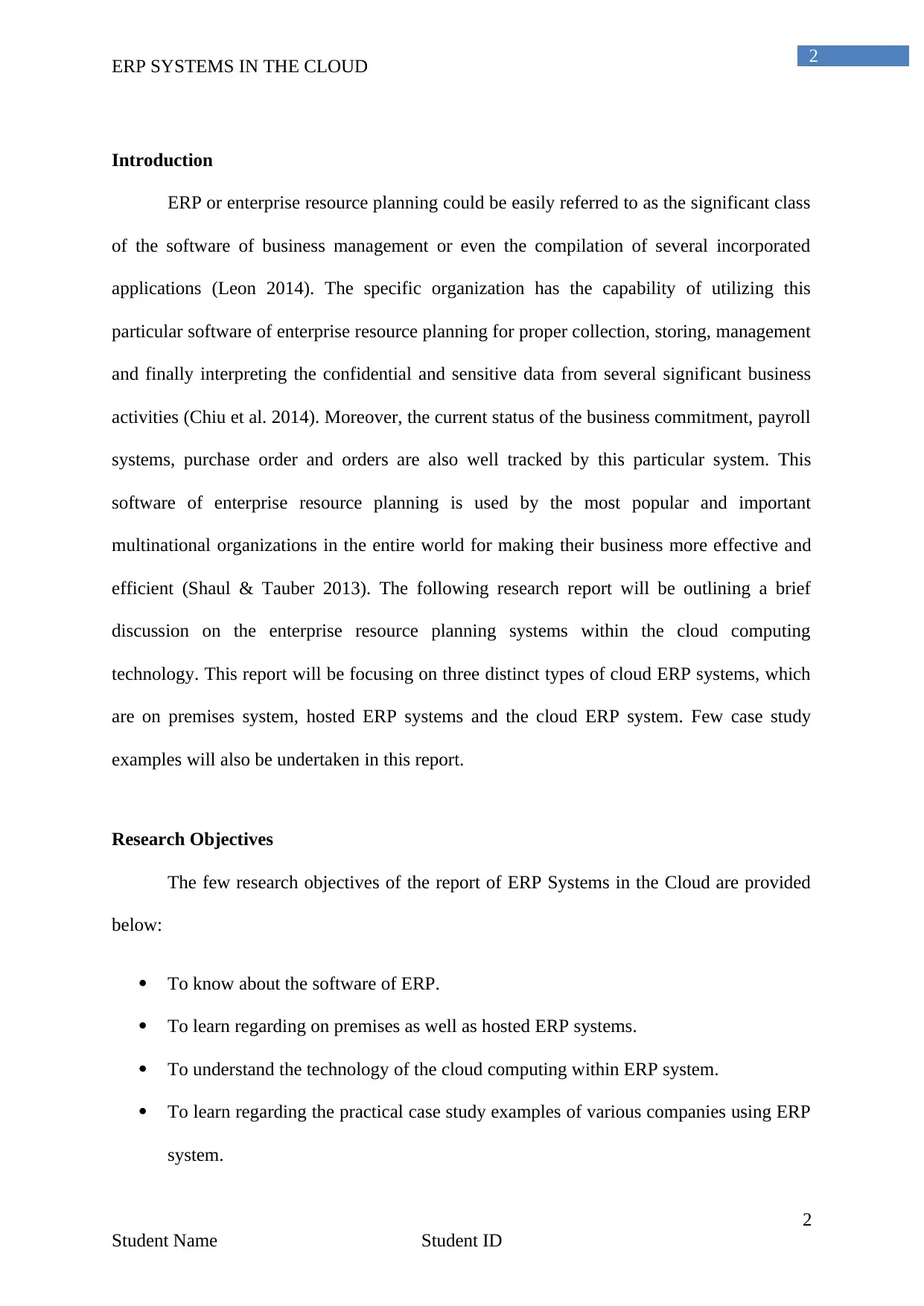
ERP SYSTEMS IN THE CLOUD
Introduction
ERP or enterprise resource planning could be easily referred to as the significant class
of the software of business management or even the compilation of several incorporated
applications (Leon 2014). The specific organization has the capability of utilizing this
particular software of enterprise resource planning for proper collection, storing, management
and finally interpreting the confidential and sensitive data from several significant business
activities (Chiu et al. 2014). Moreover, the current status of the business commitment, payroll
systems, purchase order and orders are also well tracked by this particular system. This
software of enterprise resource planning is used by the most popular and important
multinational organizations in the entire world for making their business more effective and
efficient (Shaul & Tauber 2013). The following research report will be outlining a brief
discussion on the enterprise resource planning systems within the cloud computing
technology. This report will be focusing on three distinct types of cloud ERP systems, which
are on premises system, hosted ERP systems and the cloud ERP system. Few case study
examples will also be undertaken in this report.
Research Objectives
The few research objectives of the report of ERP Systems in the Cloud are provided
below:
To know about the software of ERP.
To learn regarding on premises as well as hosted ERP systems.
To understand the technology of the cloud computing within ERP system.
To learn regarding the practical case study examples of various companies using ERP
system.
2
Student Name Student ID
2
Introduction
ERP or enterprise resource planning could be easily referred to as the significant class
of the software of business management or even the compilation of several incorporated
applications (Leon 2014). The specific organization has the capability of utilizing this
particular software of enterprise resource planning for proper collection, storing, management
and finally interpreting the confidential and sensitive data from several significant business
activities (Chiu et al. 2014). Moreover, the current status of the business commitment, payroll
systems, purchase order and orders are also well tracked by this particular system. This
software of enterprise resource planning is used by the most popular and important
multinational organizations in the entire world for making their business more effective and
efficient (Shaul & Tauber 2013). The following research report will be outlining a brief
discussion on the enterprise resource planning systems within the cloud computing
technology. This report will be focusing on three distinct types of cloud ERP systems, which
are on premises system, hosted ERP systems and the cloud ERP system. Few case study
examples will also be undertaken in this report.
Research Objectives
The few research objectives of the report of ERP Systems in the Cloud are provided
below:
To know about the software of ERP.
To learn regarding on premises as well as hosted ERP systems.
To understand the technology of the cloud computing within ERP system.
To learn regarding the practical case study examples of various companies using ERP
system.
2
Student Name Student ID
2
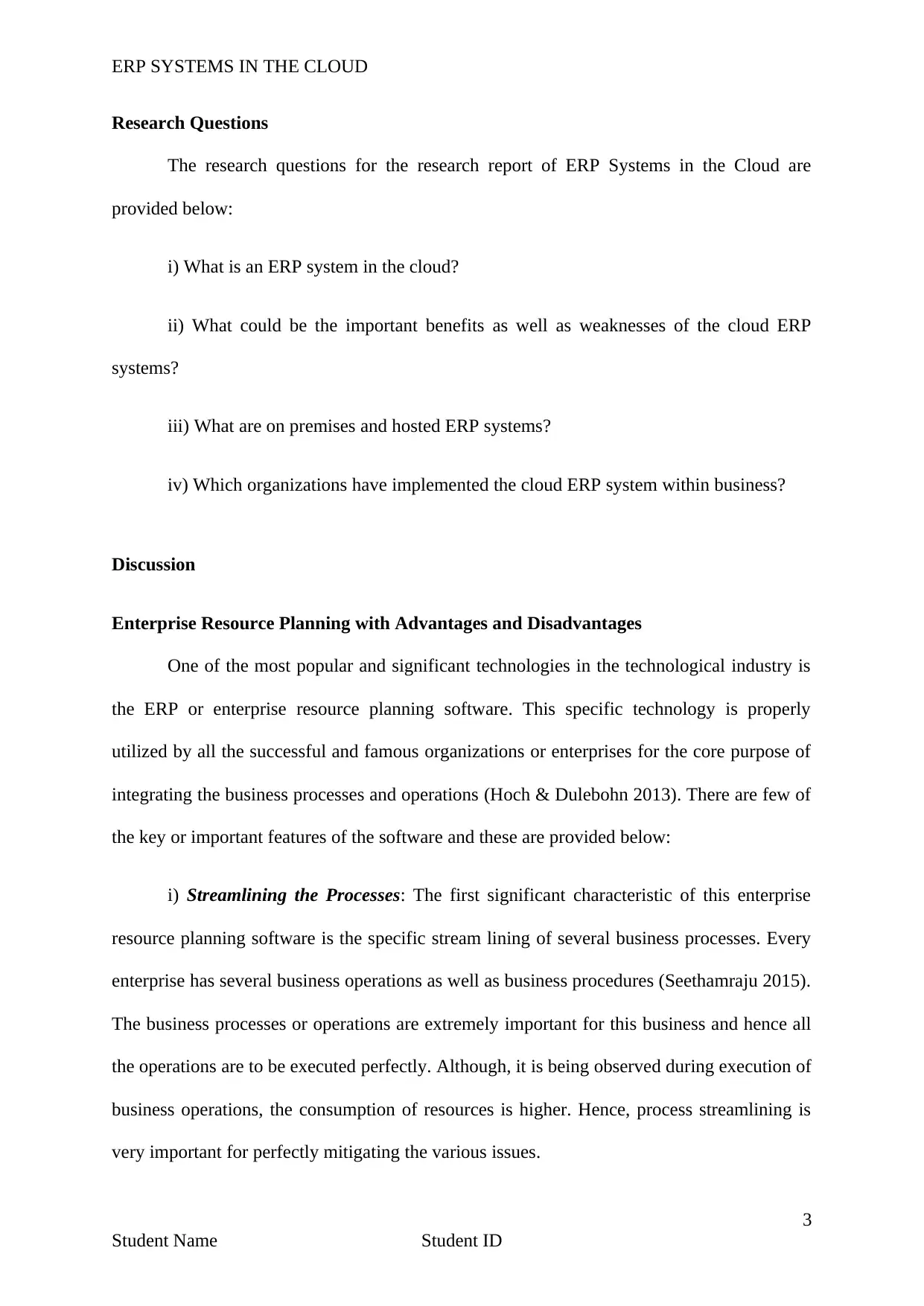
ERP SYSTEMS IN THE CLOUD
Research Questions
The research questions for the research report of ERP Systems in the Cloud are
provided below:
i) What is an ERP system in the cloud?
ii) What could be the important benefits as well as weaknesses of the cloud ERP
systems?
iii) What are on premises and hosted ERP systems?
iv) Which organizations have implemented the cloud ERP system within business?
Discussion
Enterprise Resource Planning with Advantages and Disadvantages
One of the most popular and significant technologies in the technological industry is
the ERP or enterprise resource planning software. This specific technology is properly
utilized by all the successful and famous organizations or enterprises for the core purpose of
integrating the business processes and operations (Hoch & Dulebohn 2013). There are few of
the key or important features of the software and these are provided below:
i) Streamlining the Processes: The first significant characteristic of this enterprise
resource planning software is the specific stream lining of several business processes. Every
enterprise has several business operations as well as business procedures (Seethamraju 2015).
The business processes or operations are extremely important for this business and hence all
the operations are to be executed perfectly. Although, it is being observed during execution of
business operations, the consumption of resources is higher. Hence, process streamlining is
very important for perfectly mitigating the various issues.
3
Student Name Student ID
Research Questions
The research questions for the research report of ERP Systems in the Cloud are
provided below:
i) What is an ERP system in the cloud?
ii) What could be the important benefits as well as weaknesses of the cloud ERP
systems?
iii) What are on premises and hosted ERP systems?
iv) Which organizations have implemented the cloud ERP system within business?
Discussion
Enterprise Resource Planning with Advantages and Disadvantages
One of the most popular and significant technologies in the technological industry is
the ERP or enterprise resource planning software. This specific technology is properly
utilized by all the successful and famous organizations or enterprises for the core purpose of
integrating the business processes and operations (Hoch & Dulebohn 2013). There are few of
the key or important features of the software and these are provided below:
i) Streamlining the Processes: The first significant characteristic of this enterprise
resource planning software is the specific stream lining of several business processes. Every
enterprise has several business operations as well as business procedures (Seethamraju 2015).
The business processes or operations are extremely important for this business and hence all
the operations are to be executed perfectly. Although, it is being observed during execution of
business operations, the consumption of resources is higher. Hence, process streamlining is
very important for perfectly mitigating the various issues.
3
Student Name Student ID
Secure Best Marks with AI Grader
Need help grading? Try our AI Grader for instant feedback on your assignments.
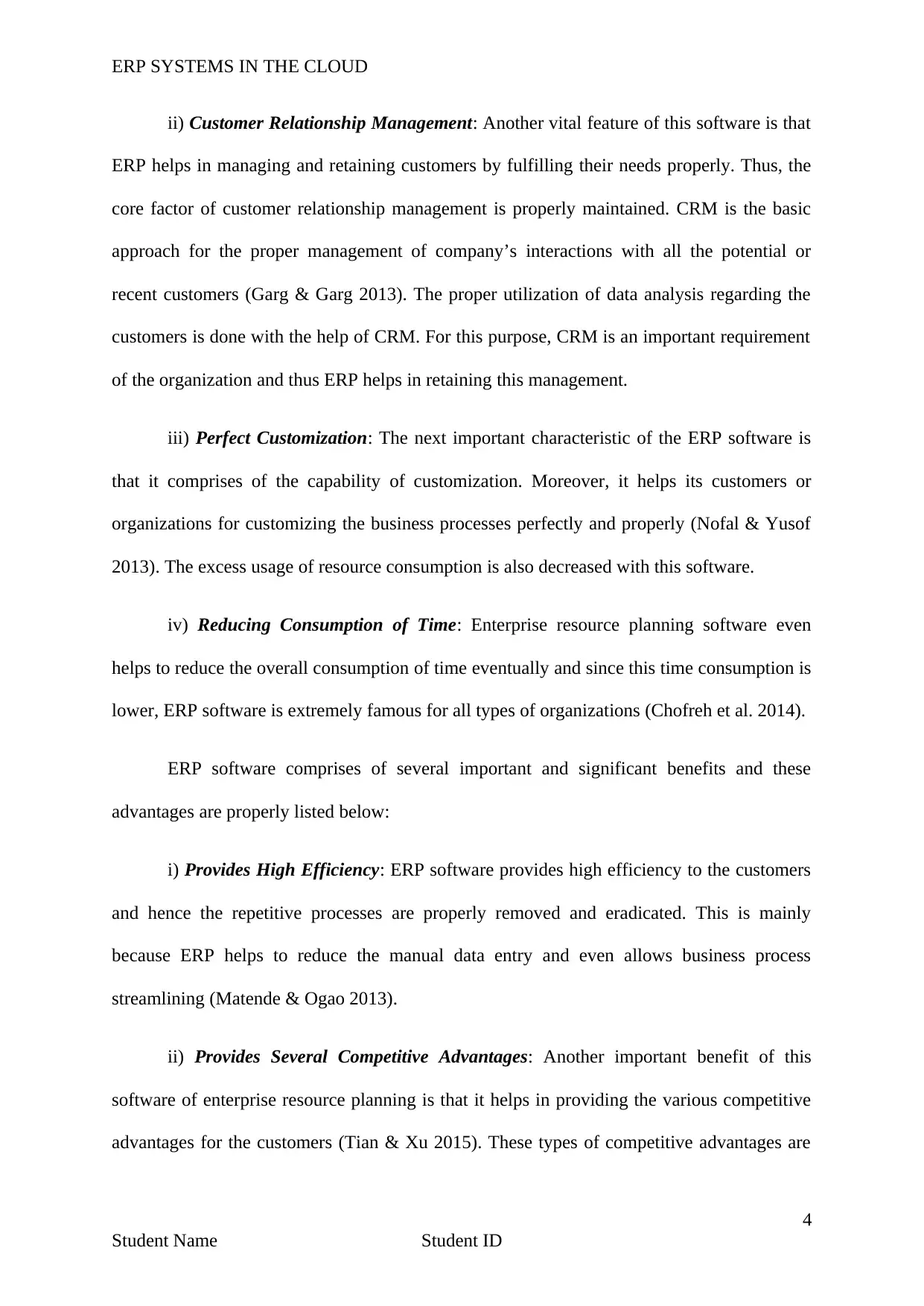
ERP SYSTEMS IN THE CLOUD
ii) Customer Relationship Management: Another vital feature of this software is that
ERP helps in managing and retaining customers by fulfilling their needs properly. Thus, the
core factor of customer relationship management is properly maintained. CRM is the basic
approach for the proper management of company’s interactions with all the potential or
recent customers (Garg & Garg 2013). The proper utilization of data analysis regarding the
customers is done with the help of CRM. For this purpose, CRM is an important requirement
of the organization and thus ERP helps in retaining this management.
iii) Perfect Customization: The next important characteristic of the ERP software is
that it comprises of the capability of customization. Moreover, it helps its customers or
organizations for customizing the business processes perfectly and properly (Nofal & Yusof
2013). The excess usage of resource consumption is also decreased with this software.
iv) Reducing Consumption of Time: Enterprise resource planning software even
helps to reduce the overall consumption of time eventually and since this time consumption is
lower, ERP software is extremely famous for all types of organizations (Chofreh et al. 2014).
ERP software comprises of several important and significant benefits and these
advantages are properly listed below:
i) Provides High Efficiency: ERP software provides high efficiency to the customers
and hence the repetitive processes are properly removed and eradicated. This is mainly
because ERP helps to reduce the manual data entry and even allows business process
streamlining (Matende & Ogao 2013).
ii) Provides Several Competitive Advantages: Another important benefit of this
software of enterprise resource planning is that it helps in providing the various competitive
advantages for the customers (Tian & Xu 2015). These types of competitive advantages are
4
Student Name Student ID
ii) Customer Relationship Management: Another vital feature of this software is that
ERP helps in managing and retaining customers by fulfilling their needs properly. Thus, the
core factor of customer relationship management is properly maintained. CRM is the basic
approach for the proper management of company’s interactions with all the potential or
recent customers (Garg & Garg 2013). The proper utilization of data analysis regarding the
customers is done with the help of CRM. For this purpose, CRM is an important requirement
of the organization and thus ERP helps in retaining this management.
iii) Perfect Customization: The next important characteristic of the ERP software is
that it comprises of the capability of customization. Moreover, it helps its customers or
organizations for customizing the business processes perfectly and properly (Nofal & Yusof
2013). The excess usage of resource consumption is also decreased with this software.
iv) Reducing Consumption of Time: Enterprise resource planning software even
helps to reduce the overall consumption of time eventually and since this time consumption is
lower, ERP software is extremely famous for all types of organizations (Chofreh et al. 2014).
ERP software comprises of several important and significant benefits and these
advantages are properly listed below:
i) Provides High Efficiency: ERP software provides high efficiency to the customers
and hence the repetitive processes are properly removed and eradicated. This is mainly
because ERP helps to reduce the manual data entry and even allows business process
streamlining (Matende & Ogao 2013).
ii) Provides Several Competitive Advantages: Another important benefit of this
software of enterprise resource planning is that it helps in providing the various competitive
advantages for the customers (Tian & Xu 2015). These types of competitive advantages are
4
Student Name Student ID
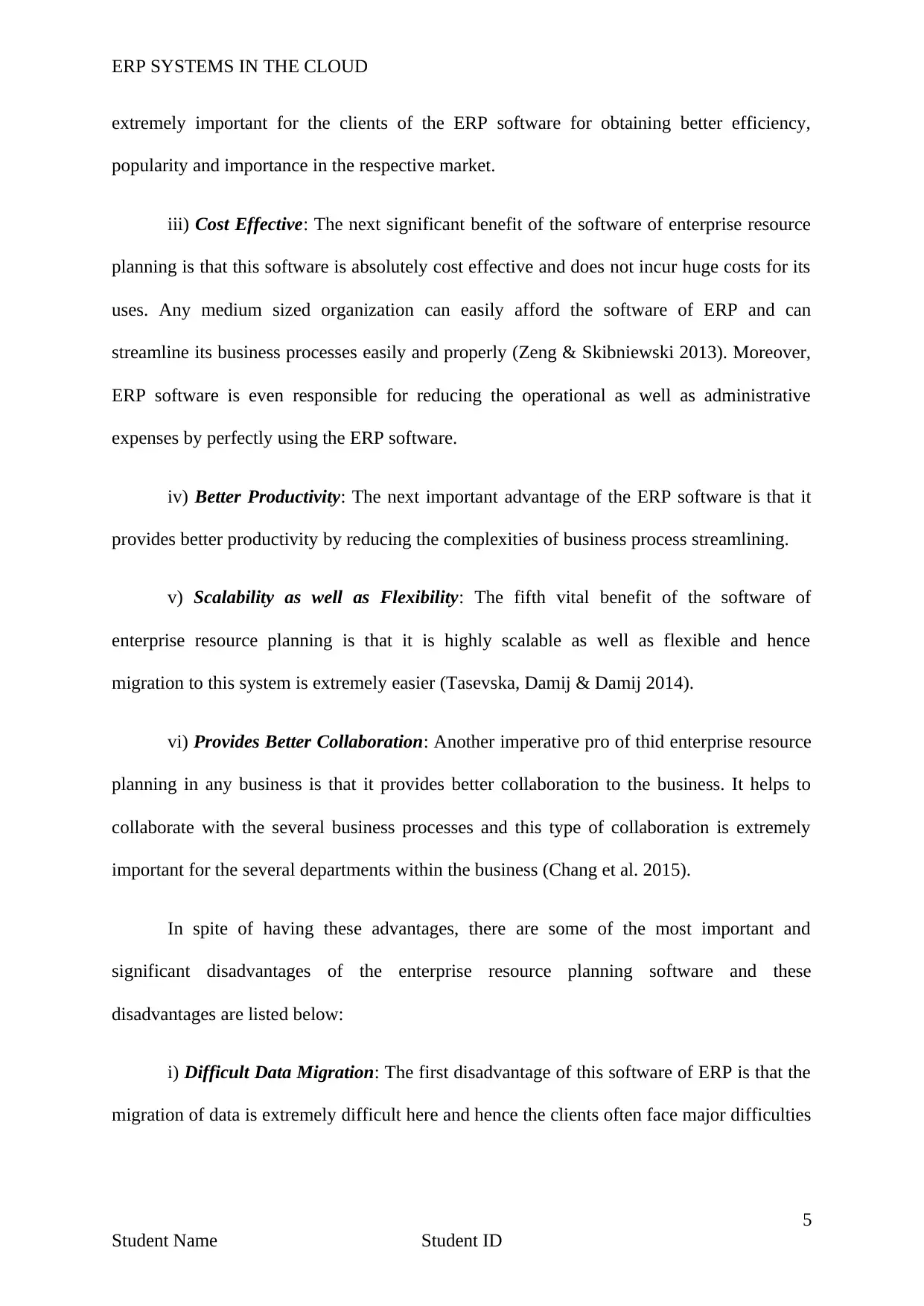
ERP SYSTEMS IN THE CLOUD
extremely important for the clients of the ERP software for obtaining better efficiency,
popularity and importance in the respective market.
iii) Cost Effective: The next significant benefit of the software of enterprise resource
planning is that this software is absolutely cost effective and does not incur huge costs for its
uses. Any medium sized organization can easily afford the software of ERP and can
streamline its business processes easily and properly (Zeng & Skibniewski 2013). Moreover,
ERP software is even responsible for reducing the operational as well as administrative
expenses by perfectly using the ERP software.
iv) Better Productivity: The next important advantage of the ERP software is that it
provides better productivity by reducing the complexities of business process streamlining.
v) Scalability as well as Flexibility: The fifth vital benefit of the software of
enterprise resource planning is that it is highly scalable as well as flexible and hence
migration to this system is extremely easier (Tasevska, Damij & Damij 2014).
vi) Provides Better Collaboration: Another imperative pro of thid enterprise resource
planning in any business is that it provides better collaboration to the business. It helps to
collaborate with the several business processes and this type of collaboration is extremely
important for the several departments within the business (Chang et al. 2015).
In spite of having these advantages, there are some of the most important and
significant disadvantages of the enterprise resource planning software and these
disadvantages are listed below:
i) Difficult Data Migration: The first disadvantage of this software of ERP is that the
migration of data is extremely difficult here and hence the clients often face major difficulties
5
Student Name Student ID
extremely important for the clients of the ERP software for obtaining better efficiency,
popularity and importance in the respective market.
iii) Cost Effective: The next significant benefit of the software of enterprise resource
planning is that this software is absolutely cost effective and does not incur huge costs for its
uses. Any medium sized organization can easily afford the software of ERP and can
streamline its business processes easily and properly (Zeng & Skibniewski 2013). Moreover,
ERP software is even responsible for reducing the operational as well as administrative
expenses by perfectly using the ERP software.
iv) Better Productivity: The next important advantage of the ERP software is that it
provides better productivity by reducing the complexities of business process streamlining.
v) Scalability as well as Flexibility: The fifth vital benefit of the software of
enterprise resource planning is that it is highly scalable as well as flexible and hence
migration to this system is extremely easier (Tasevska, Damij & Damij 2014).
vi) Provides Better Collaboration: Another imperative pro of thid enterprise resource
planning in any business is that it provides better collaboration to the business. It helps to
collaborate with the several business processes and this type of collaboration is extremely
important for the several departments within the business (Chang et al. 2015).
In spite of having these advantages, there are some of the most important and
significant disadvantages of the enterprise resource planning software and these
disadvantages are listed below:
i) Difficult Data Migration: The first disadvantage of this software of ERP is that the
migration of data is extremely difficult here and hence the clients often face major difficulties
5
Student Name Student ID
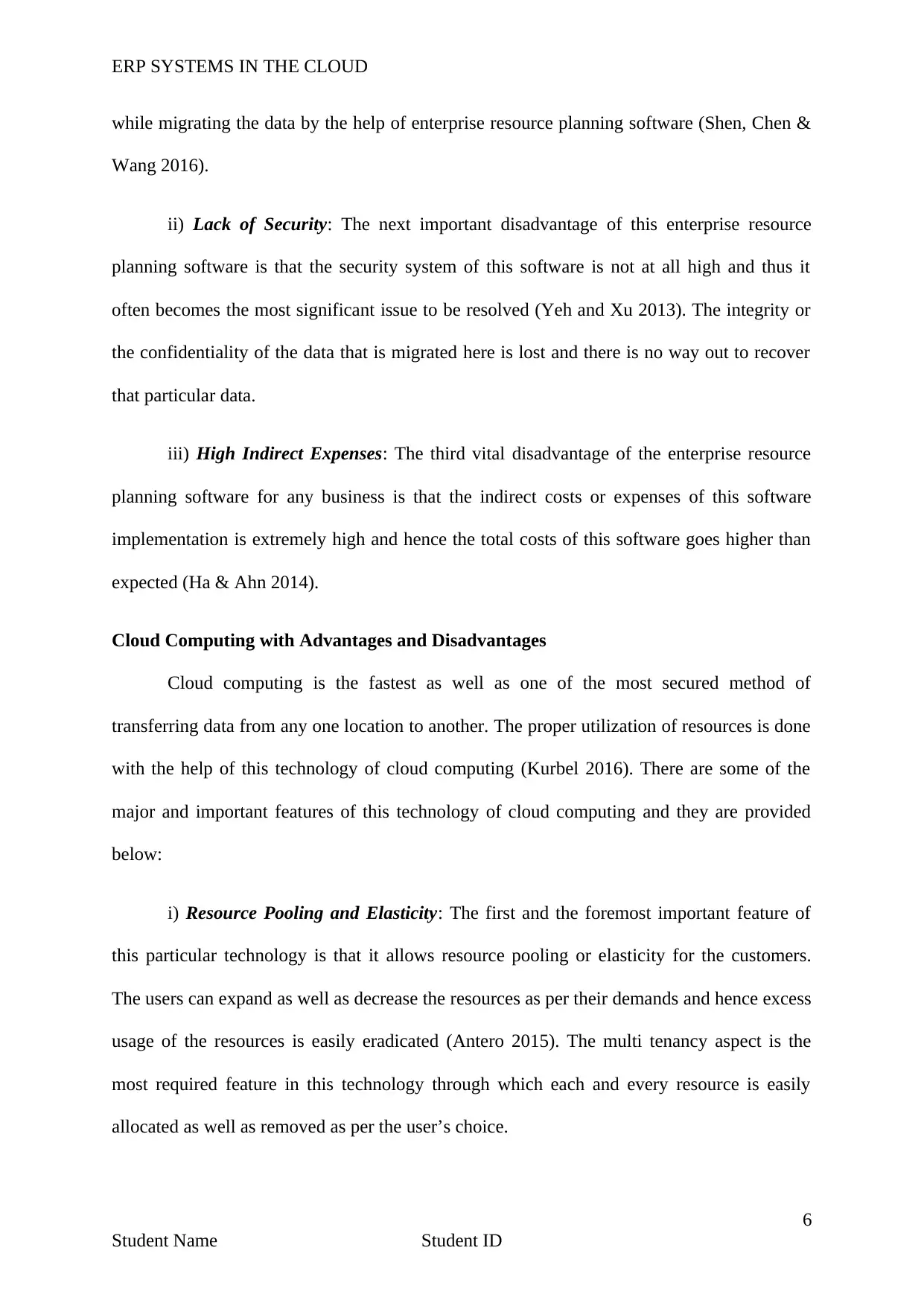
ERP SYSTEMS IN THE CLOUD
while migrating the data by the help of enterprise resource planning software (Shen, Chen &
Wang 2016).
ii) Lack of Security: The next important disadvantage of this enterprise resource
planning software is that the security system of this software is not at all high and thus it
often becomes the most significant issue to be resolved (Yeh and Xu 2013). The integrity or
the confidentiality of the data that is migrated here is lost and there is no way out to recover
that particular data.
iii) High Indirect Expenses: The third vital disadvantage of the enterprise resource
planning software for any business is that the indirect costs or expenses of this software
implementation is extremely high and hence the total costs of this software goes higher than
expected (Ha & Ahn 2014).
Cloud Computing with Advantages and Disadvantages
Cloud computing is the fastest as well as one of the most secured method of
transferring data from any one location to another. The proper utilization of resources is done
with the help of this technology of cloud computing (Kurbel 2016). There are some of the
major and important features of this technology of cloud computing and they are provided
below:
i) Resource Pooling and Elasticity: The first and the foremost important feature of
this particular technology is that it allows resource pooling or elasticity for the customers.
The users can expand as well as decrease the resources as per their demands and hence excess
usage of the resources is easily eradicated (Antero 2015). The multi tenancy aspect is the
most required feature in this technology through which each and every resource is easily
allocated as well as removed as per the user’s choice.
6
Student Name Student ID
while migrating the data by the help of enterprise resource planning software (Shen, Chen &
Wang 2016).
ii) Lack of Security: The next important disadvantage of this enterprise resource
planning software is that the security system of this software is not at all high and thus it
often becomes the most significant issue to be resolved (Yeh and Xu 2013). The integrity or
the confidentiality of the data that is migrated here is lost and there is no way out to recover
that particular data.
iii) High Indirect Expenses: The third vital disadvantage of the enterprise resource
planning software for any business is that the indirect costs or expenses of this software
implementation is extremely high and hence the total costs of this software goes higher than
expected (Ha & Ahn 2014).
Cloud Computing with Advantages and Disadvantages
Cloud computing is the fastest as well as one of the most secured method of
transferring data from any one location to another. The proper utilization of resources is done
with the help of this technology of cloud computing (Kurbel 2016). There are some of the
major and important features of this technology of cloud computing and they are provided
below:
i) Resource Pooling and Elasticity: The first and the foremost important feature of
this particular technology is that it allows resource pooling or elasticity for the customers.
The users can expand as well as decrease the resources as per their demands and hence excess
usage of the resources is easily eradicated (Antero 2015). The multi tenancy aspect is the
most required feature in this technology through which each and every resource is easily
allocated as well as removed as per the user’s choice.
6
Student Name Student ID
Paraphrase This Document
Need a fresh take? Get an instant paraphrase of this document with our AI Paraphraser
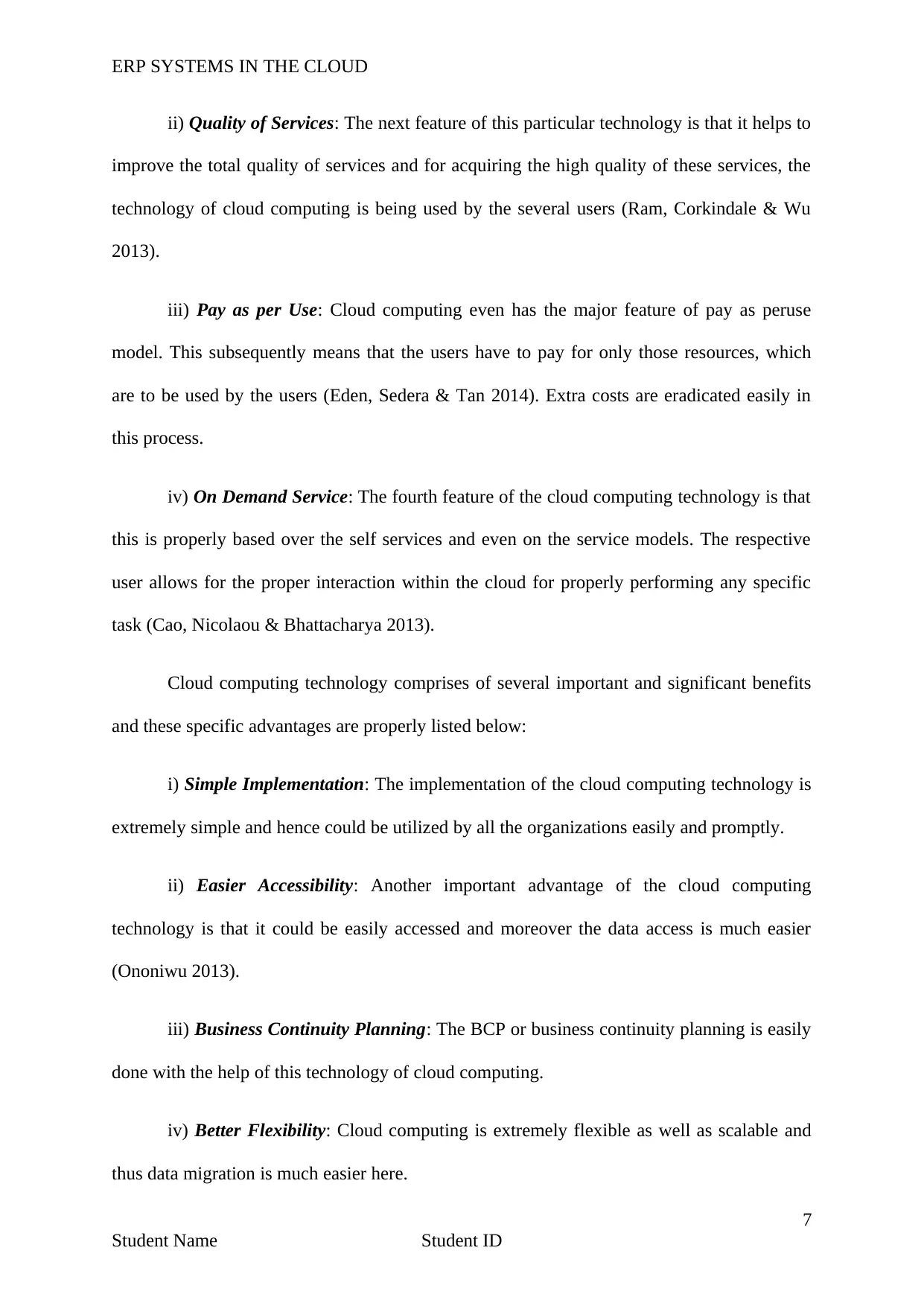
ERP SYSTEMS IN THE CLOUD
ii) Quality of Services: The next feature of this particular technology is that it helps to
improve the total quality of services and for acquiring the high quality of these services, the
technology of cloud computing is being used by the several users (Ram, Corkindale & Wu
2013).
iii) Pay as per Use: Cloud computing even has the major feature of pay as peruse
model. This subsequently means that the users have to pay for only those resources, which
are to be used by the users (Eden, Sedera & Tan 2014). Extra costs are eradicated easily in
this process.
iv) On Demand Service: The fourth feature of the cloud computing technology is that
this is properly based over the self services and even on the service models. The respective
user allows for the proper interaction within the cloud for properly performing any specific
task (Cao, Nicolaou & Bhattacharya 2013).
Cloud computing technology comprises of several important and significant benefits
and these specific advantages are properly listed below:
i) Simple Implementation: The implementation of the cloud computing technology is
extremely simple and hence could be utilized by all the organizations easily and promptly.
ii) Easier Accessibility: Another important advantage of the cloud computing
technology is that it could be easily accessed and moreover the data access is much easier
(Ononiwu 2013).
iii) Business Continuity Planning: The BCP or business continuity planning is easily
done with the help of this technology of cloud computing.
iv) Better Flexibility: Cloud computing is extremely flexible as well as scalable and
thus data migration is much easier here.
7
Student Name Student ID
ii) Quality of Services: The next feature of this particular technology is that it helps to
improve the total quality of services and for acquiring the high quality of these services, the
technology of cloud computing is being used by the several users (Ram, Corkindale & Wu
2013).
iii) Pay as per Use: Cloud computing even has the major feature of pay as peruse
model. This subsequently means that the users have to pay for only those resources, which
are to be used by the users (Eden, Sedera & Tan 2014). Extra costs are eradicated easily in
this process.
iv) On Demand Service: The fourth feature of the cloud computing technology is that
this is properly based over the self services and even on the service models. The respective
user allows for the proper interaction within the cloud for properly performing any specific
task (Cao, Nicolaou & Bhattacharya 2013).
Cloud computing technology comprises of several important and significant benefits
and these specific advantages are properly listed below:
i) Simple Implementation: The implementation of the cloud computing technology is
extremely simple and hence could be utilized by all the organizations easily and promptly.
ii) Easier Accessibility: Another important advantage of the cloud computing
technology is that it could be easily accessed and moreover the data access is much easier
(Ononiwu 2013).
iii) Business Continuity Planning: The BCP or business continuity planning is easily
done with the help of this technology of cloud computing.
iv) Better Flexibility: Cloud computing is extremely flexible as well as scalable and
thus data migration is much easier here.
7
Student Name Student ID
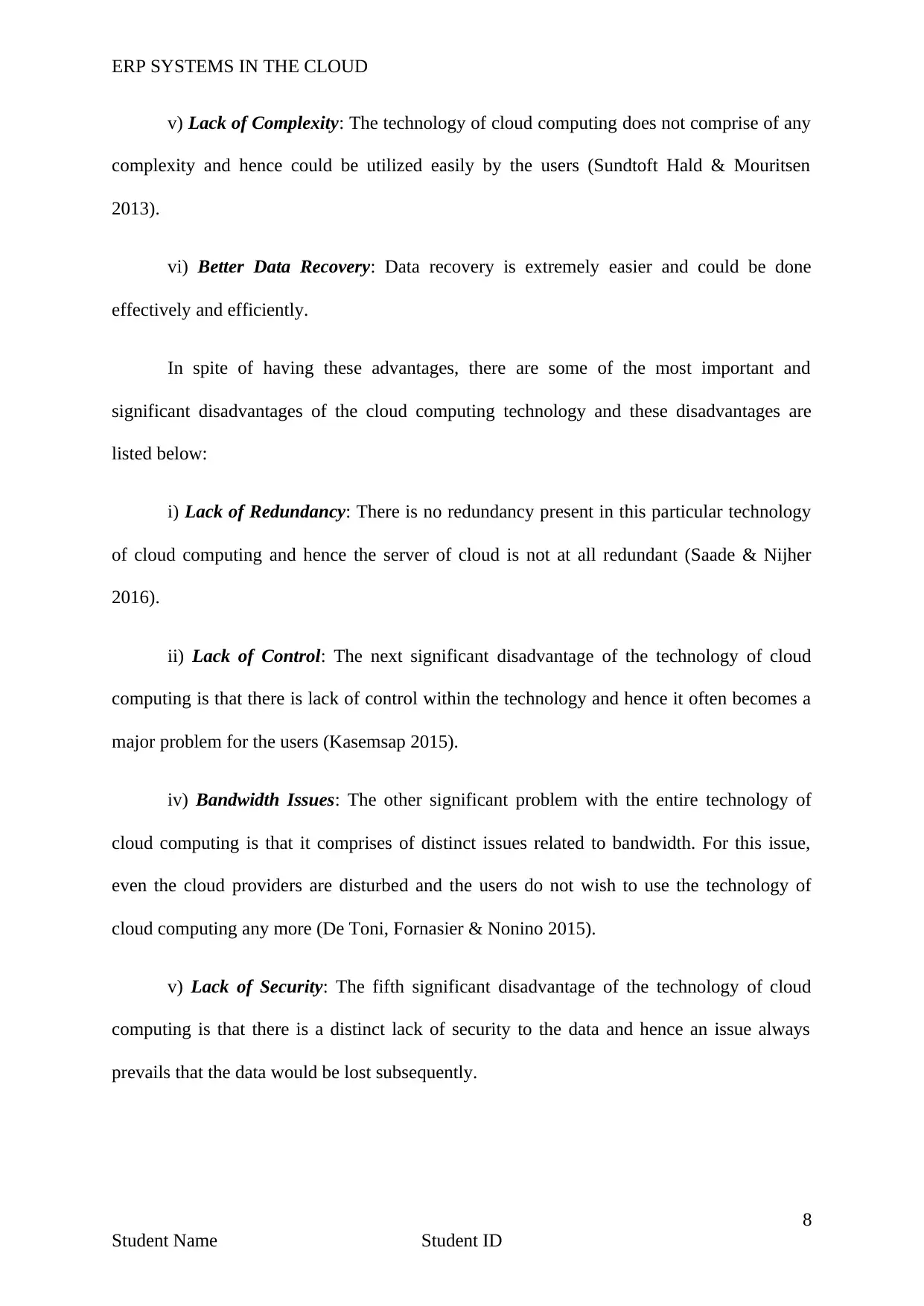
ERP SYSTEMS IN THE CLOUD
v) Lack of Complexity: The technology of cloud computing does not comprise of any
complexity and hence could be utilized easily by the users (Sundtoft Hald & Mouritsen
2013).
vi) Better Data Recovery: Data recovery is extremely easier and could be done
effectively and efficiently.
In spite of having these advantages, there are some of the most important and
significant disadvantages of the cloud computing technology and these disadvantages are
listed below:
i) Lack of Redundancy: There is no redundancy present in this particular technology
of cloud computing and hence the server of cloud is not at all redundant (Saade & Nijher
2016).
ii) Lack of Control: The next significant disadvantage of the technology of cloud
computing is that there is lack of control within the technology and hence it often becomes a
major problem for the users (Kasemsap 2015).
iv) Bandwidth Issues: The other significant problem with the entire technology of
cloud computing is that it comprises of distinct issues related to bandwidth. For this issue,
even the cloud providers are disturbed and the users do not wish to use the technology of
cloud computing any more (De Toni, Fornasier & Nonino 2015).
v) Lack of Security: The fifth significant disadvantage of the technology of cloud
computing is that there is a distinct lack of security to the data and hence an issue always
prevails that the data would be lost subsequently.
8
Student Name Student ID
v) Lack of Complexity: The technology of cloud computing does not comprise of any
complexity and hence could be utilized easily by the users (Sundtoft Hald & Mouritsen
2013).
vi) Better Data Recovery: Data recovery is extremely easier and could be done
effectively and efficiently.
In spite of having these advantages, there are some of the most important and
significant disadvantages of the cloud computing technology and these disadvantages are
listed below:
i) Lack of Redundancy: There is no redundancy present in this particular technology
of cloud computing and hence the server of cloud is not at all redundant (Saade & Nijher
2016).
ii) Lack of Control: The next significant disadvantage of the technology of cloud
computing is that there is lack of control within the technology and hence it often becomes a
major problem for the users (Kasemsap 2015).
iv) Bandwidth Issues: The other significant problem with the entire technology of
cloud computing is that it comprises of distinct issues related to bandwidth. For this issue,
even the cloud providers are disturbed and the users do not wish to use the technology of
cloud computing any more (De Toni, Fornasier & Nonino 2015).
v) Lack of Security: The fifth significant disadvantage of the technology of cloud
computing is that there is a distinct lack of security to the data and hence an issue always
prevails that the data would be lost subsequently.
8
Student Name Student ID
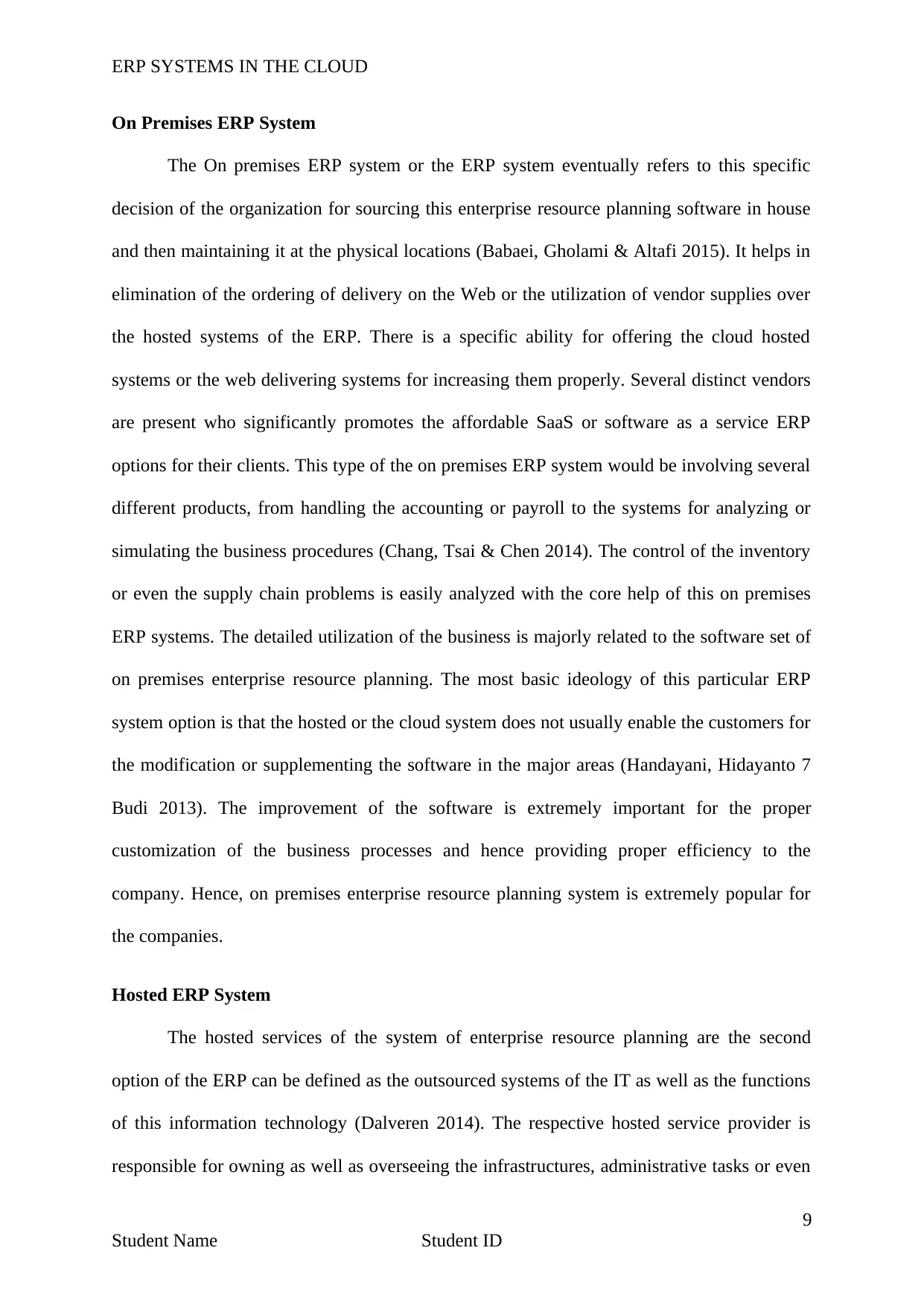
ERP SYSTEMS IN THE CLOUD
On Premises ERP System
The On premises ERP system or the ERP system eventually refers to this specific
decision of the organization for sourcing this enterprise resource planning software in house
and then maintaining it at the physical locations (Babaei, Gholami & Altafi 2015). It helps in
elimination of the ordering of delivery on the Web or the utilization of vendor supplies over
the hosted systems of the ERP. There is a specific ability for offering the cloud hosted
systems or the web delivering systems for increasing them properly. Several distinct vendors
are present who significantly promotes the affordable SaaS or software as a service ERP
options for their clients. This type of the on premises ERP system would be involving several
different products, from handling the accounting or payroll to the systems for analyzing or
simulating the business procedures (Chang, Tsai & Chen 2014). The control of the inventory
or even the supply chain problems is easily analyzed with the core help of this on premises
ERP systems. The detailed utilization of the business is majorly related to the software set of
on premises enterprise resource planning. The most basic ideology of this particular ERP
system option is that the hosted or the cloud system does not usually enable the customers for
the modification or supplementing the software in the major areas (Handayani, Hidayanto 7
Budi 2013). The improvement of the software is extremely important for the proper
customization of the business processes and hence providing proper efficiency to the
company. Hence, on premises enterprise resource planning system is extremely popular for
the companies.
Hosted ERP System
The hosted services of the system of enterprise resource planning are the second
option of the ERP can be defined as the outsourced systems of the IT as well as the functions
of this information technology (Dalveren 2014). The respective hosted service provider is
responsible for owning as well as overseeing the infrastructures, administrative tasks or even
9
Student Name Student ID
On Premises ERP System
The On premises ERP system or the ERP system eventually refers to this specific
decision of the organization for sourcing this enterprise resource planning software in house
and then maintaining it at the physical locations (Babaei, Gholami & Altafi 2015). It helps in
elimination of the ordering of delivery on the Web or the utilization of vendor supplies over
the hosted systems of the ERP. There is a specific ability for offering the cloud hosted
systems or the web delivering systems for increasing them properly. Several distinct vendors
are present who significantly promotes the affordable SaaS or software as a service ERP
options for their clients. This type of the on premises ERP system would be involving several
different products, from handling the accounting or payroll to the systems for analyzing or
simulating the business procedures (Chang, Tsai & Chen 2014). The control of the inventory
or even the supply chain problems is easily analyzed with the core help of this on premises
ERP systems. The detailed utilization of the business is majorly related to the software set of
on premises enterprise resource planning. The most basic ideology of this particular ERP
system option is that the hosted or the cloud system does not usually enable the customers for
the modification or supplementing the software in the major areas (Handayani, Hidayanto 7
Budi 2013). The improvement of the software is extremely important for the proper
customization of the business processes and hence providing proper efficiency to the
company. Hence, on premises enterprise resource planning system is extremely popular for
the companies.
Hosted ERP System
The hosted services of the system of enterprise resource planning are the second
option of the ERP can be defined as the outsourced systems of the IT as well as the functions
of this information technology (Dalveren 2014). The respective hosted service provider is
responsible for owning as well as overseeing the infrastructures, administrative tasks or even
9
Student Name Student ID
Secure Best Marks with AI Grader
Need help grading? Try our AI Grader for instant feedback on your assignments.
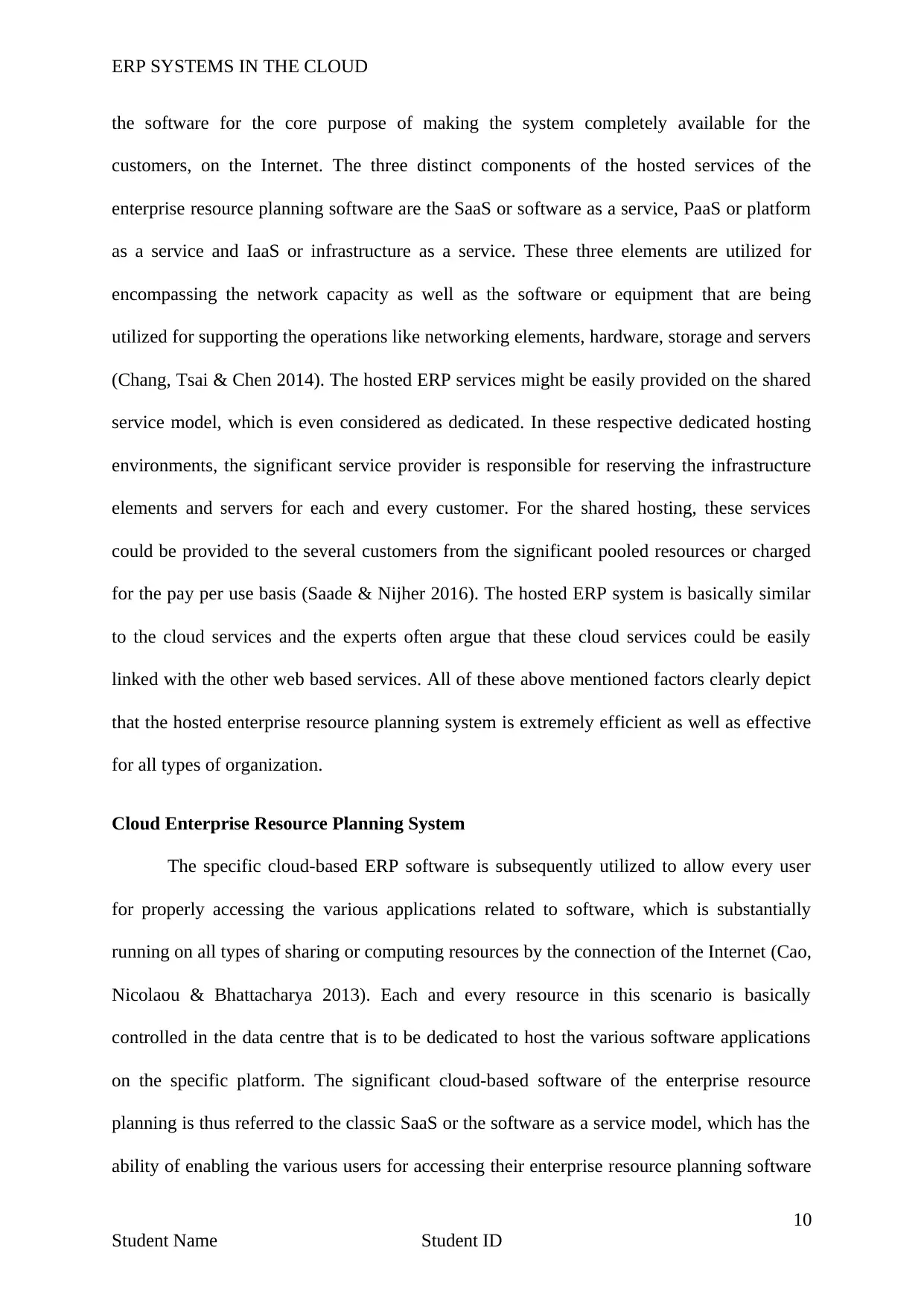
ERP SYSTEMS IN THE CLOUD
the software for the core purpose of making the system completely available for the
customers, on the Internet. The three distinct components of the hosted services of the
enterprise resource planning software are the SaaS or software as a service, PaaS or platform
as a service and IaaS or infrastructure as a service. These three elements are utilized for
encompassing the network capacity as well as the software or equipment that are being
utilized for supporting the operations like networking elements, hardware, storage and servers
(Chang, Tsai & Chen 2014). The hosted ERP services might be easily provided on the shared
service model, which is even considered as dedicated. In these respective dedicated hosting
environments, the significant service provider is responsible for reserving the infrastructure
elements and servers for each and every customer. For the shared hosting, these services
could be provided to the several customers from the significant pooled resources or charged
for the pay per use basis (Saade & Nijher 2016). The hosted ERP system is basically similar
to the cloud services and the experts often argue that these cloud services could be easily
linked with the other web based services. All of these above mentioned factors clearly depict
that the hosted enterprise resource planning system is extremely efficient as well as effective
for all types of organization.
Cloud Enterprise Resource Planning System
The specific cloud-based ERP software is subsequently utilized to allow every user
for properly accessing the various applications related to software, which is substantially
running on all types of sharing or computing resources by the connection of the Internet (Cao,
Nicolaou & Bhattacharya 2013). Each and every resource in this scenario is basically
controlled in the data centre that is to be dedicated to host the various software applications
on the specific platform. The significant cloud-based software of the enterprise resource
planning is thus referred to the classic SaaS or the software as a service model, which has the
ability of enabling the various users for accessing their enterprise resource planning software
10
Student Name Student ID
the software for the core purpose of making the system completely available for the
customers, on the Internet. The three distinct components of the hosted services of the
enterprise resource planning software are the SaaS or software as a service, PaaS or platform
as a service and IaaS or infrastructure as a service. These three elements are utilized for
encompassing the network capacity as well as the software or equipment that are being
utilized for supporting the operations like networking elements, hardware, storage and servers
(Chang, Tsai & Chen 2014). The hosted ERP services might be easily provided on the shared
service model, which is even considered as dedicated. In these respective dedicated hosting
environments, the significant service provider is responsible for reserving the infrastructure
elements and servers for each and every customer. For the shared hosting, these services
could be provided to the several customers from the significant pooled resources or charged
for the pay per use basis (Saade & Nijher 2016). The hosted ERP system is basically similar
to the cloud services and the experts often argue that these cloud services could be easily
linked with the other web based services. All of these above mentioned factors clearly depict
that the hosted enterprise resource planning system is extremely efficient as well as effective
for all types of organization.
Cloud Enterprise Resource Planning System
The specific cloud-based ERP software is subsequently utilized to allow every user
for properly accessing the various applications related to software, which is substantially
running on all types of sharing or computing resources by the connection of the Internet (Cao,
Nicolaou & Bhattacharya 2013). Each and every resource in this scenario is basically
controlled in the data centre that is to be dedicated to host the various software applications
on the specific platform. The significant cloud-based software of the enterprise resource
planning is thus referred to the classic SaaS or the software as a service model, which has the
ability of enabling the various users for accessing their enterprise resource planning software
10
Student Name Student ID
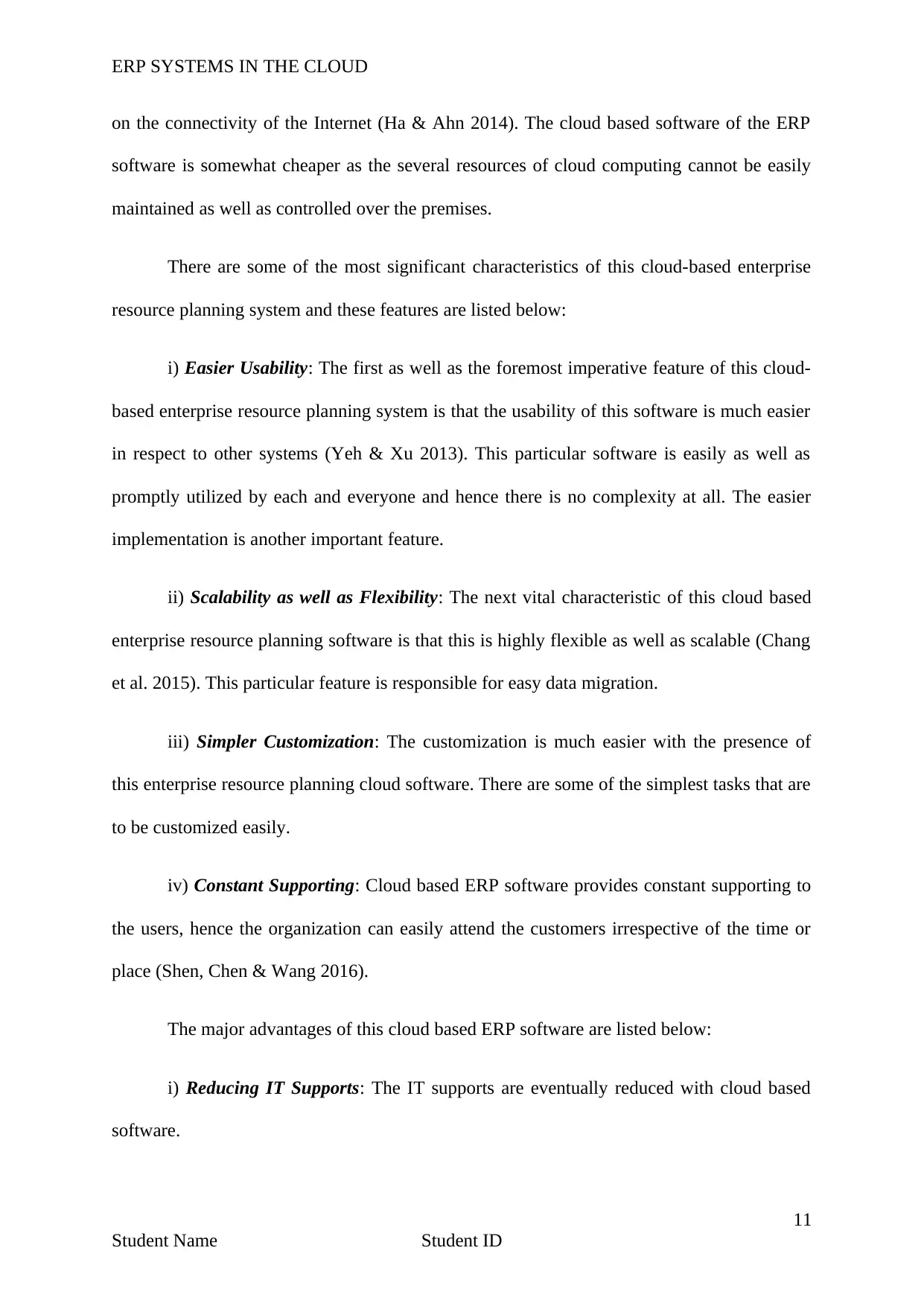
ERP SYSTEMS IN THE CLOUD
on the connectivity of the Internet (Ha & Ahn 2014). The cloud based software of the ERP
software is somewhat cheaper as the several resources of cloud computing cannot be easily
maintained as well as controlled over the premises.
There are some of the most significant characteristics of this cloud-based enterprise
resource planning system and these features are listed below:
i) Easier Usability: The first as well as the foremost imperative feature of this cloud-
based enterprise resource planning system is that the usability of this software is much easier
in respect to other systems (Yeh & Xu 2013). This particular software is easily as well as
promptly utilized by each and everyone and hence there is no complexity at all. The easier
implementation is another important feature.
ii) Scalability as well as Flexibility: The next vital characteristic of this cloud based
enterprise resource planning software is that this is highly flexible as well as scalable (Chang
et al. 2015). This particular feature is responsible for easy data migration.
iii) Simpler Customization: The customization is much easier with the presence of
this enterprise resource planning cloud software. There are some of the simplest tasks that are
to be customized easily.
iv) Constant Supporting: Cloud based ERP software provides constant supporting to
the users, hence the organization can easily attend the customers irrespective of the time or
place (Shen, Chen & Wang 2016).
The major advantages of this cloud based ERP software are listed below:
i) Reducing IT Supports: The IT supports are eventually reduced with cloud based
software.
11
Student Name Student ID
on the connectivity of the Internet (Ha & Ahn 2014). The cloud based software of the ERP
software is somewhat cheaper as the several resources of cloud computing cannot be easily
maintained as well as controlled over the premises.
There are some of the most significant characteristics of this cloud-based enterprise
resource planning system and these features are listed below:
i) Easier Usability: The first as well as the foremost imperative feature of this cloud-
based enterprise resource planning system is that the usability of this software is much easier
in respect to other systems (Yeh & Xu 2013). This particular software is easily as well as
promptly utilized by each and everyone and hence there is no complexity at all. The easier
implementation is another important feature.
ii) Scalability as well as Flexibility: The next vital characteristic of this cloud based
enterprise resource planning software is that this is highly flexible as well as scalable (Chang
et al. 2015). This particular feature is responsible for easy data migration.
iii) Simpler Customization: The customization is much easier with the presence of
this enterprise resource planning cloud software. There are some of the simplest tasks that are
to be customized easily.
iv) Constant Supporting: Cloud based ERP software provides constant supporting to
the users, hence the organization can easily attend the customers irrespective of the time or
place (Shen, Chen & Wang 2016).
The major advantages of this cloud based ERP software are listed below:
i) Reducing IT Supports: The IT supports are eventually reduced with cloud based
software.
11
Student Name Student ID
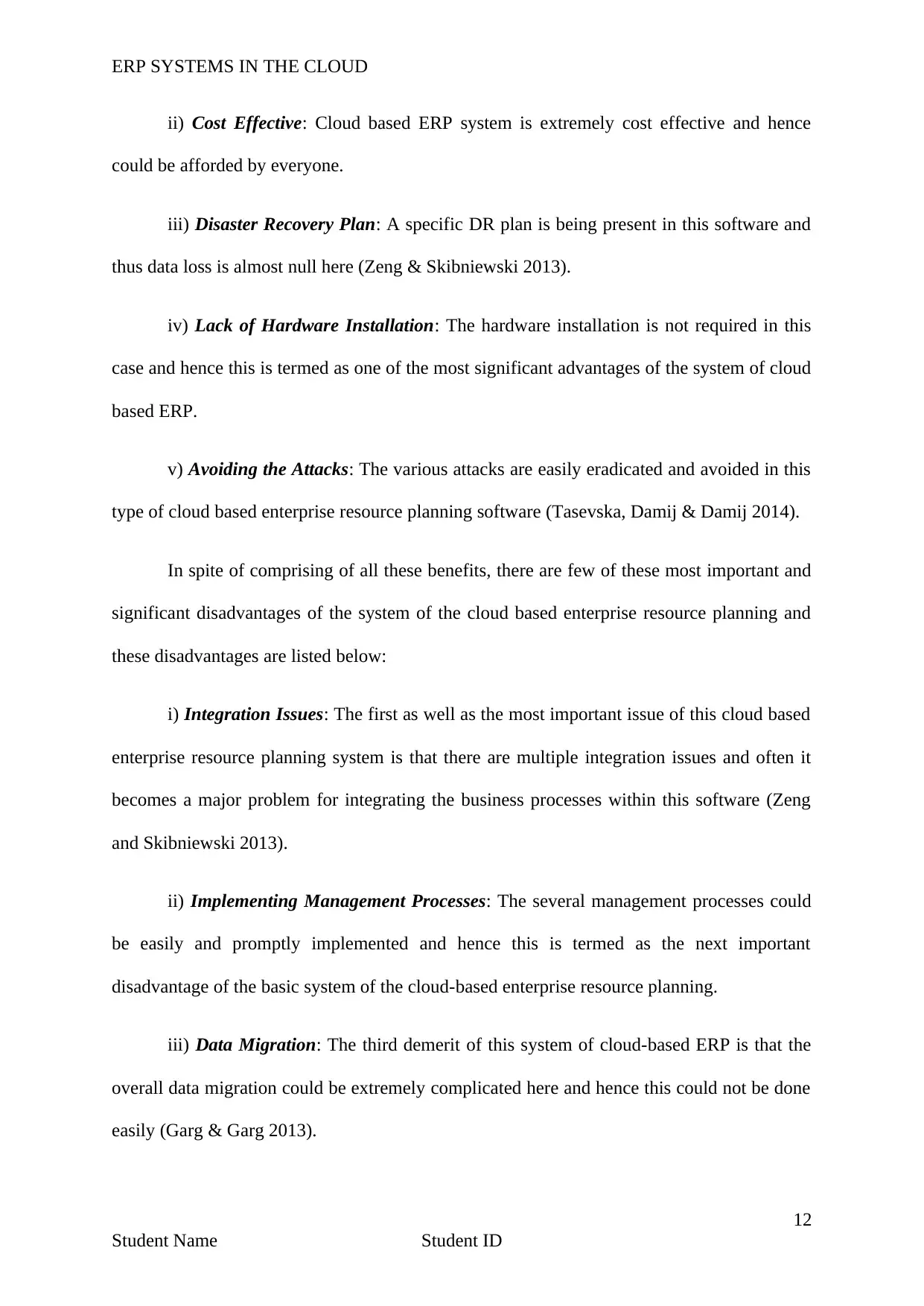
ERP SYSTEMS IN THE CLOUD
ii) Cost Effective: Cloud based ERP system is extremely cost effective and hence
could be afforded by everyone.
iii) Disaster Recovery Plan: A specific DR plan is being present in this software and
thus data loss is almost null here (Zeng & Skibniewski 2013).
iv) Lack of Hardware Installation: The hardware installation is not required in this
case and hence this is termed as one of the most significant advantages of the system of cloud
based ERP.
v) Avoiding the Attacks: The various attacks are easily eradicated and avoided in this
type of cloud based enterprise resource planning software (Tasevska, Damij & Damij 2014).
In spite of comprising of all these benefits, there are few of these most important and
significant disadvantages of the system of the cloud based enterprise resource planning and
these disadvantages are listed below:
i) Integration Issues: The first as well as the most important issue of this cloud based
enterprise resource planning system is that there are multiple integration issues and often it
becomes a major problem for integrating the business processes within this software (Zeng
and Skibniewski 2013).
ii) Implementing Management Processes: The several management processes could
be easily and promptly implemented and hence this is termed as the next important
disadvantage of the basic system of the cloud-based enterprise resource planning.
iii) Data Migration: The third demerit of this system of cloud-based ERP is that the
overall data migration could be extremely complicated here and hence this could not be done
easily (Garg & Garg 2013).
12
Student Name Student ID
ii) Cost Effective: Cloud based ERP system is extremely cost effective and hence
could be afforded by everyone.
iii) Disaster Recovery Plan: A specific DR plan is being present in this software and
thus data loss is almost null here (Zeng & Skibniewski 2013).
iv) Lack of Hardware Installation: The hardware installation is not required in this
case and hence this is termed as one of the most significant advantages of the system of cloud
based ERP.
v) Avoiding the Attacks: The various attacks are easily eradicated and avoided in this
type of cloud based enterprise resource planning software (Tasevska, Damij & Damij 2014).
In spite of comprising of all these benefits, there are few of these most important and
significant disadvantages of the system of the cloud based enterprise resource planning and
these disadvantages are listed below:
i) Integration Issues: The first as well as the most important issue of this cloud based
enterprise resource planning system is that there are multiple integration issues and often it
becomes a major problem for integrating the business processes within this software (Zeng
and Skibniewski 2013).
ii) Implementing Management Processes: The several management processes could
be easily and promptly implemented and hence this is termed as the next important
disadvantage of the basic system of the cloud-based enterprise resource planning.
iii) Data Migration: The third demerit of this system of cloud-based ERP is that the
overall data migration could be extremely complicated here and hence this could not be done
easily (Garg & Garg 2013).
12
Student Name Student ID
Paraphrase This Document
Need a fresh take? Get an instant paraphrase of this document with our AI Paraphraser
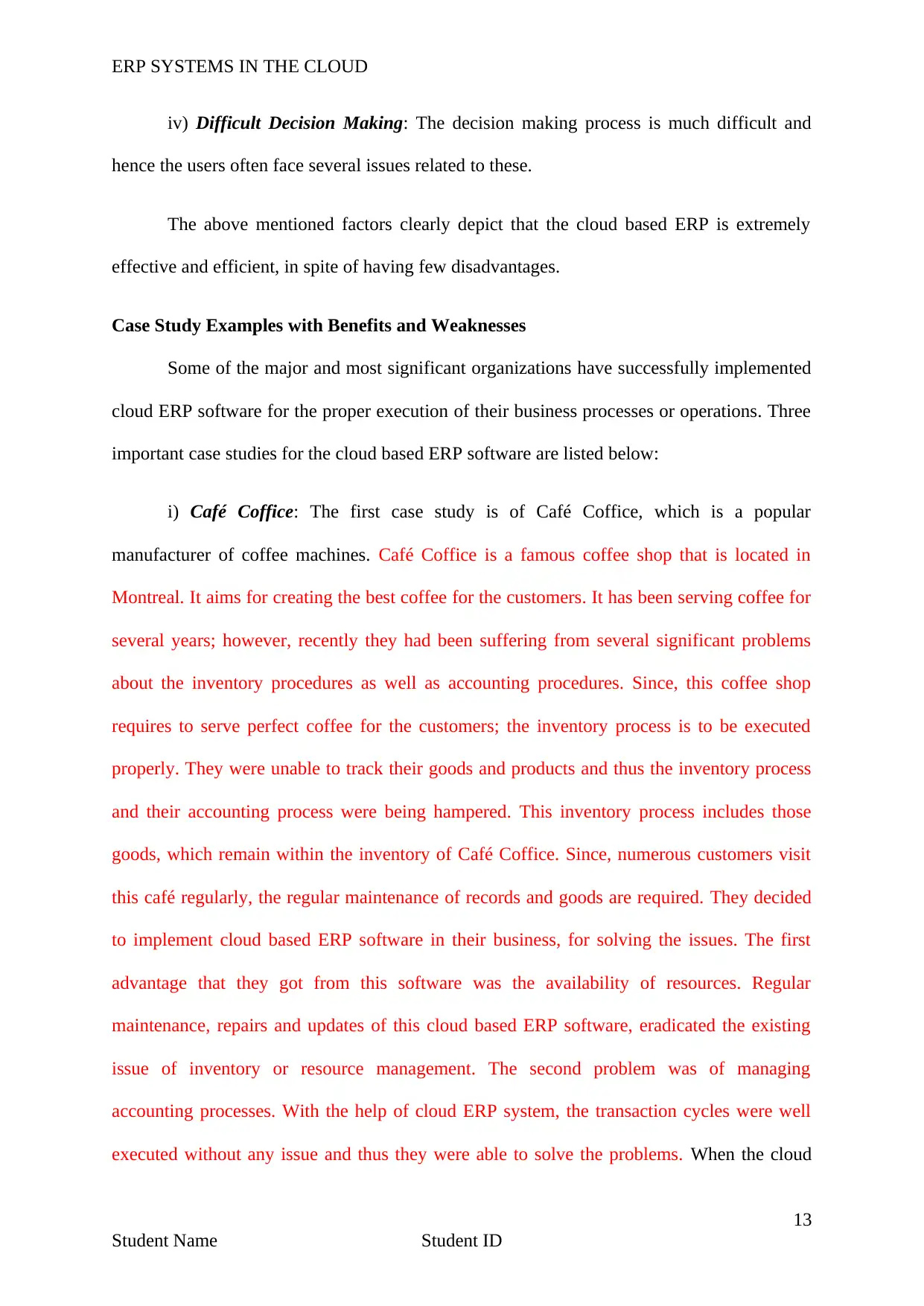
ERP SYSTEMS IN THE CLOUD
iv) Difficult Decision Making: The decision making process is much difficult and
hence the users often face several issues related to these.
The above mentioned factors clearly depict that the cloud based ERP is extremely
effective and efficient, in spite of having few disadvantages.
Case Study Examples with Benefits and Weaknesses
Some of the major and most significant organizations have successfully implemented
cloud ERP software for the proper execution of their business processes or operations. Three
important case studies for the cloud based ERP software are listed below:
i) Café Coffice: The first case study is of Café Coffice, which is a popular
manufacturer of coffee machines. Café Coffice is a famous coffee shop that is located in
Montreal. It aims for creating the best coffee for the customers. It has been serving coffee for
several years; however, recently they had been suffering from several significant problems
about the inventory procedures as well as accounting procedures. Since, this coffee shop
requires to serve perfect coffee for the customers; the inventory process is to be executed
properly. They were unable to track their goods and products and thus the inventory process
and their accounting process were being hampered. This inventory process includes those
goods, which remain within the inventory of Café Coffice. Since, numerous customers visit
this café regularly, the regular maintenance of records and goods are required. They decided
to implement cloud based ERP software in their business, for solving the issues. The first
advantage that they got from this software was the availability of resources. Regular
maintenance, repairs and updates of this cloud based ERP software, eradicated the existing
issue of inventory or resource management. The second problem was of managing
accounting processes. With the help of cloud ERP system, the transaction cycles were well
executed without any issue and thus they were able to solve the problems. When the cloud
13
Student Name Student ID
iv) Difficult Decision Making: The decision making process is much difficult and
hence the users often face several issues related to these.
The above mentioned factors clearly depict that the cloud based ERP is extremely
effective and efficient, in spite of having few disadvantages.
Case Study Examples with Benefits and Weaknesses
Some of the major and most significant organizations have successfully implemented
cloud ERP software for the proper execution of their business processes or operations. Three
important case studies for the cloud based ERP software are listed below:
i) Café Coffice: The first case study is of Café Coffice, which is a popular
manufacturer of coffee machines. Café Coffice is a famous coffee shop that is located in
Montreal. It aims for creating the best coffee for the customers. It has been serving coffee for
several years; however, recently they had been suffering from several significant problems
about the inventory procedures as well as accounting procedures. Since, this coffee shop
requires to serve perfect coffee for the customers; the inventory process is to be executed
properly. They were unable to track their goods and products and thus the inventory process
and their accounting process were being hampered. This inventory process includes those
goods, which remain within the inventory of Café Coffice. Since, numerous customers visit
this café regularly, the regular maintenance of records and goods are required. They decided
to implement cloud based ERP software in their business, for solving the issues. The first
advantage that they got from this software was the availability of resources. Regular
maintenance, repairs and updates of this cloud based ERP software, eradicated the existing
issue of inventory or resource management. The second problem was of managing
accounting processes. With the help of cloud ERP system, the transaction cycles were well
executed without any issue and thus they were able to solve the problems. When the cloud
13
Student Name Student ID
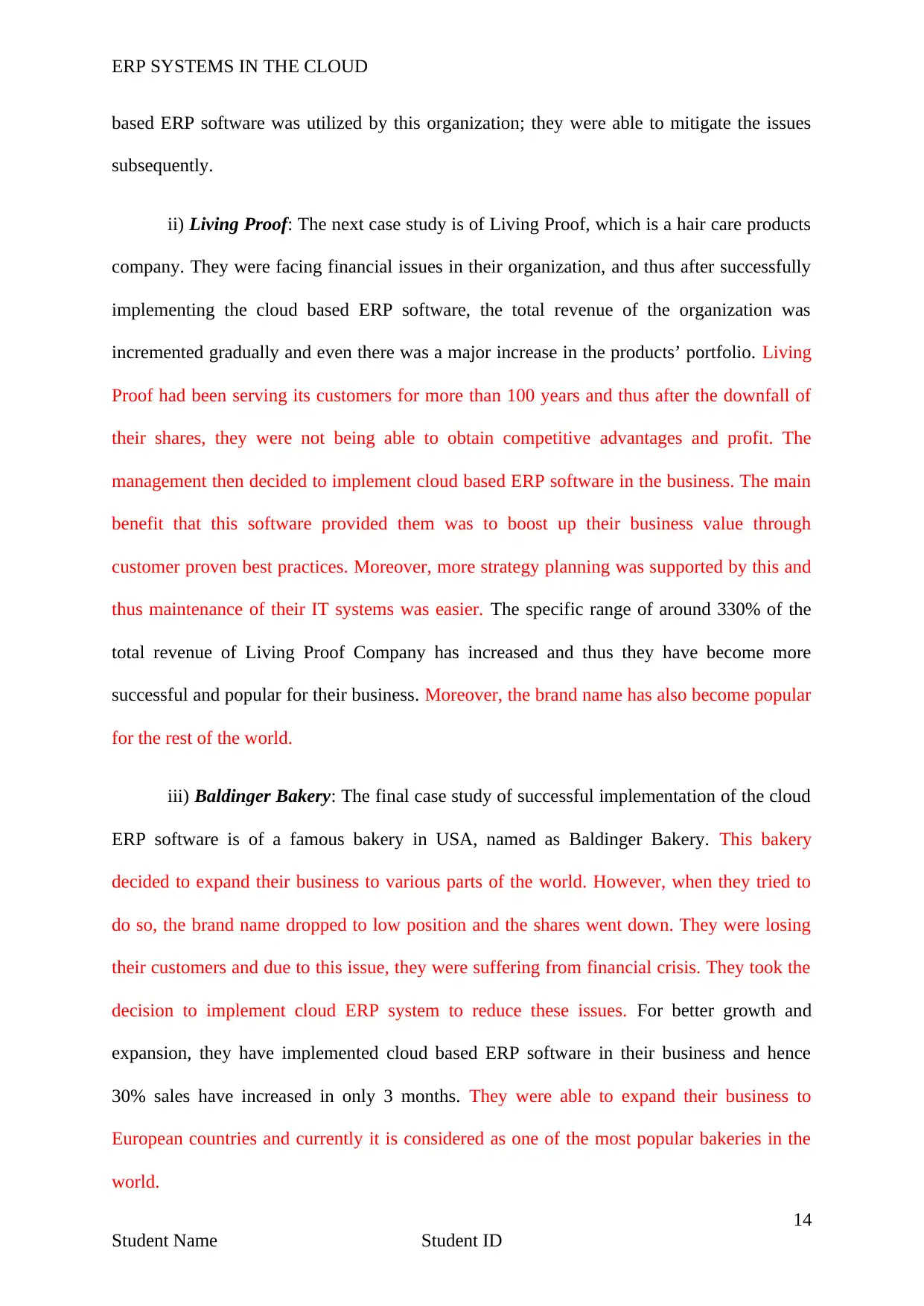
ERP SYSTEMS IN THE CLOUD
based ERP software was utilized by this organization; they were able to mitigate the issues
subsequently.
ii) Living Proof: The next case study is of Living Proof, which is a hair care products
company. They were facing financial issues in their organization, and thus after successfully
implementing the cloud based ERP software, the total revenue of the organization was
incremented gradually and even there was a major increase in the products’ portfolio. Living
Proof had been serving its customers for more than 100 years and thus after the downfall of
their shares, they were not being able to obtain competitive advantages and profit. The
management then decided to implement cloud based ERP software in the business. The main
benefit that this software provided them was to boost up their business value through
customer proven best practices. Moreover, more strategy planning was supported by this and
thus maintenance of their IT systems was easier. The specific range of around 330% of the
total revenue of Living Proof Company has increased and thus they have become more
successful and popular for their business. Moreover, the brand name has also become popular
for the rest of the world.
iii) Baldinger Bakery: The final case study of successful implementation of the cloud
ERP software is of a famous bakery in USA, named as Baldinger Bakery. This bakery
decided to expand their business to various parts of the world. However, when they tried to
do so, the brand name dropped to low position and the shares went down. They were losing
their customers and due to this issue, they were suffering from financial crisis. They took the
decision to implement cloud ERP system to reduce these issues. For better growth and
expansion, they have implemented cloud based ERP software in their business and hence
30% sales have increased in only 3 months. They were able to expand their business to
European countries and currently it is considered as one of the most popular bakeries in the
world.
14
Student Name Student ID
based ERP software was utilized by this organization; they were able to mitigate the issues
subsequently.
ii) Living Proof: The next case study is of Living Proof, which is a hair care products
company. They were facing financial issues in their organization, and thus after successfully
implementing the cloud based ERP software, the total revenue of the organization was
incremented gradually and even there was a major increase in the products’ portfolio. Living
Proof had been serving its customers for more than 100 years and thus after the downfall of
their shares, they were not being able to obtain competitive advantages and profit. The
management then decided to implement cloud based ERP software in the business. The main
benefit that this software provided them was to boost up their business value through
customer proven best practices. Moreover, more strategy planning was supported by this and
thus maintenance of their IT systems was easier. The specific range of around 330% of the
total revenue of Living Proof Company has increased and thus they have become more
successful and popular for their business. Moreover, the brand name has also become popular
for the rest of the world.
iii) Baldinger Bakery: The final case study of successful implementation of the cloud
ERP software is of a famous bakery in USA, named as Baldinger Bakery. This bakery
decided to expand their business to various parts of the world. However, when they tried to
do so, the brand name dropped to low position and the shares went down. They were losing
their customers and due to this issue, they were suffering from financial crisis. They took the
decision to implement cloud ERP system to reduce these issues. For better growth and
expansion, they have implemented cloud based ERP software in their business and hence
30% sales have increased in only 3 months. They were able to expand their business to
European countries and currently it is considered as one of the most popular bakeries in the
world.
14
Student Name Student ID
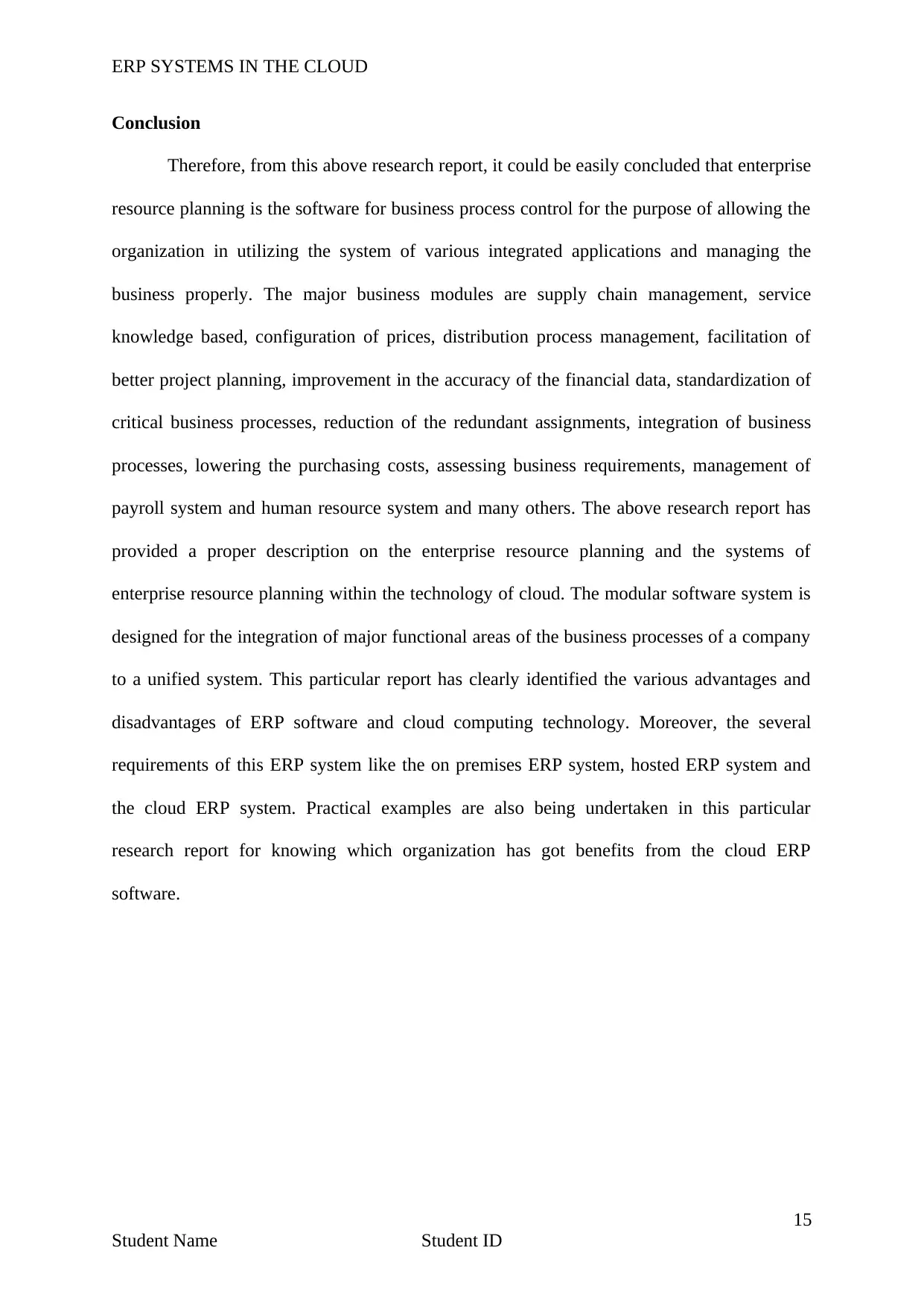
ERP SYSTEMS IN THE CLOUD
Conclusion
Therefore, from this above research report, it could be easily concluded that enterprise
resource planning is the software for business process control for the purpose of allowing the
organization in utilizing the system of various integrated applications and managing the
business properly. The major business modules are supply chain management, service
knowledge based, configuration of prices, distribution process management, facilitation of
better project planning, improvement in the accuracy of the financial data, standardization of
critical business processes, reduction of the redundant assignments, integration of business
processes, lowering the purchasing costs, assessing business requirements, management of
payroll system and human resource system and many others. The above research report has
provided a proper description on the enterprise resource planning and the systems of
enterprise resource planning within the technology of cloud. The modular software system is
designed for the integration of major functional areas of the business processes of a company
to a unified system. This particular report has clearly identified the various advantages and
disadvantages of ERP software and cloud computing technology. Moreover, the several
requirements of this ERP system like the on premises ERP system, hosted ERP system and
the cloud ERP system. Practical examples are also being undertaken in this particular
research report for knowing which organization has got benefits from the cloud ERP
software.
15
Student Name Student ID
Conclusion
Therefore, from this above research report, it could be easily concluded that enterprise
resource planning is the software for business process control for the purpose of allowing the
organization in utilizing the system of various integrated applications and managing the
business properly. The major business modules are supply chain management, service
knowledge based, configuration of prices, distribution process management, facilitation of
better project planning, improvement in the accuracy of the financial data, standardization of
critical business processes, reduction of the redundant assignments, integration of business
processes, lowering the purchasing costs, assessing business requirements, management of
payroll system and human resource system and many others. The above research report has
provided a proper description on the enterprise resource planning and the systems of
enterprise resource planning within the technology of cloud. The modular software system is
designed for the integration of major functional areas of the business processes of a company
to a unified system. This particular report has clearly identified the various advantages and
disadvantages of ERP software and cloud computing technology. Moreover, the several
requirements of this ERP system like the on premises ERP system, hosted ERP system and
the cloud ERP system. Practical examples are also being undertaken in this particular
research report for knowing which organization has got benefits from the cloud ERP
software.
15
Student Name Student ID
Secure Best Marks with AI Grader
Need help grading? Try our AI Grader for instant feedback on your assignments.
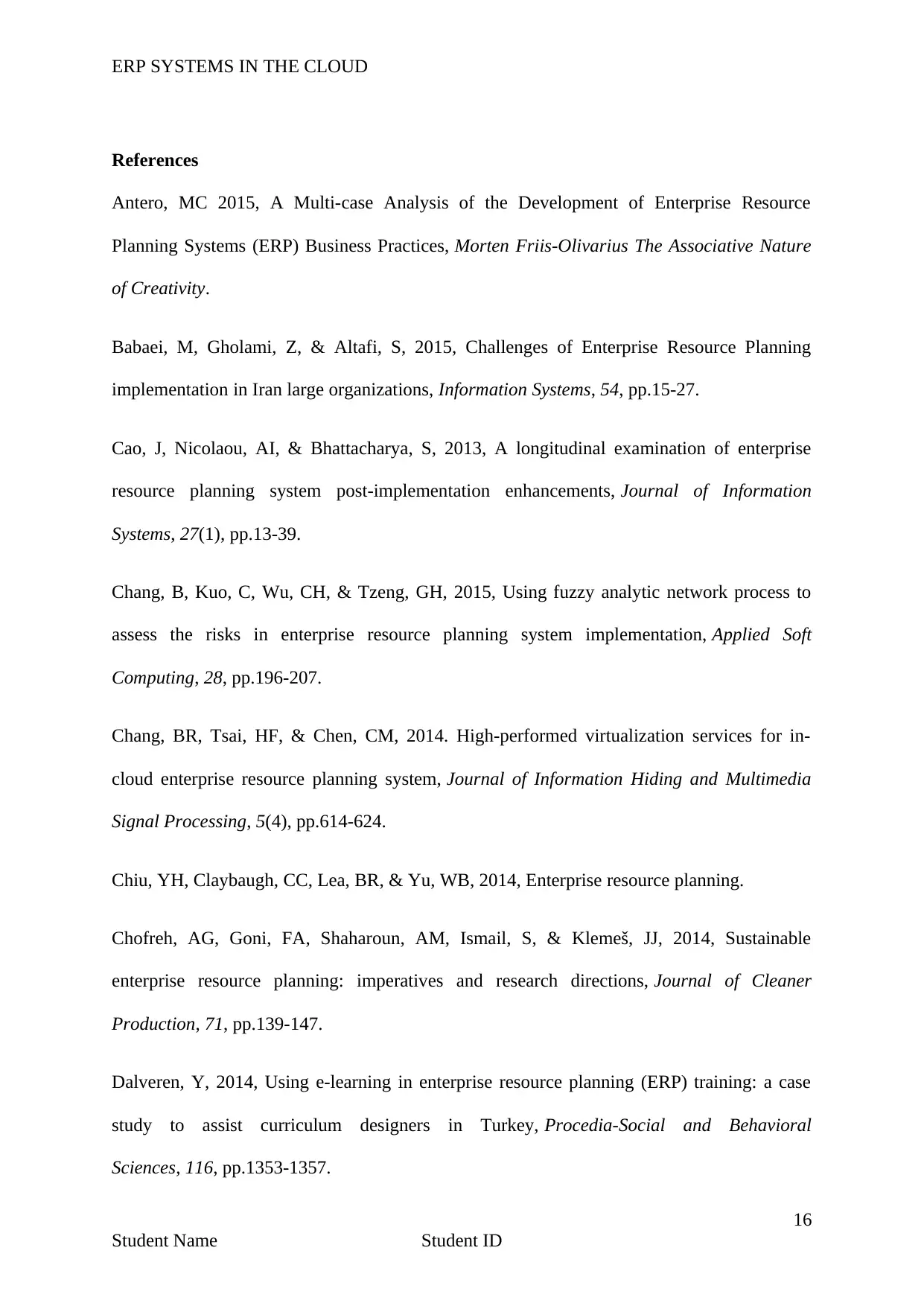
ERP SYSTEMS IN THE CLOUD
References
Antero, MC 2015, A Multi-case Analysis of the Development of Enterprise Resource
Planning Systems (ERP) Business Practices, Morten Friis-Olivarius The Associative Nature
of Creativity.
Babaei, M, Gholami, Z, & Altafi, S, 2015, Challenges of Enterprise Resource Planning
implementation in Iran large organizations, Information Systems, 54, pp.15-27.
Cao, J, Nicolaou, AI, & Bhattacharya, S, 2013, A longitudinal examination of enterprise
resource planning system post-implementation enhancements, Journal of Information
Systems, 27(1), pp.13-39.
Chang, B, Kuo, C, Wu, CH, & Tzeng, GH, 2015, Using fuzzy analytic network process to
assess the risks in enterprise resource planning system implementation, Applied Soft
Computing, 28, pp.196-207.
Chang, BR, Tsai, HF, & Chen, CM, 2014. High-performed virtualization services for in-
cloud enterprise resource planning system, Journal of Information Hiding and Multimedia
Signal Processing, 5(4), pp.614-624.
Chiu, YH, Claybaugh, CC, Lea, BR, & Yu, WB, 2014, Enterprise resource planning.
Chofreh, AG, Goni, FA, Shaharoun, AM, Ismail, S, & Klemeš, JJ, 2014, Sustainable
enterprise resource planning: imperatives and research directions, Journal of Cleaner
Production, 71, pp.139-147.
Dalveren, Y, 2014, Using e-learning in enterprise resource planning (ERP) training: a case
study to assist curriculum designers in Turkey, Procedia-Social and Behavioral
Sciences, 116, pp.1353-1357.
16
Student Name Student ID
References
Antero, MC 2015, A Multi-case Analysis of the Development of Enterprise Resource
Planning Systems (ERP) Business Practices, Morten Friis-Olivarius The Associative Nature
of Creativity.
Babaei, M, Gholami, Z, & Altafi, S, 2015, Challenges of Enterprise Resource Planning
implementation in Iran large organizations, Information Systems, 54, pp.15-27.
Cao, J, Nicolaou, AI, & Bhattacharya, S, 2013, A longitudinal examination of enterprise
resource planning system post-implementation enhancements, Journal of Information
Systems, 27(1), pp.13-39.
Chang, B, Kuo, C, Wu, CH, & Tzeng, GH, 2015, Using fuzzy analytic network process to
assess the risks in enterprise resource planning system implementation, Applied Soft
Computing, 28, pp.196-207.
Chang, BR, Tsai, HF, & Chen, CM, 2014. High-performed virtualization services for in-
cloud enterprise resource planning system, Journal of Information Hiding and Multimedia
Signal Processing, 5(4), pp.614-624.
Chiu, YH, Claybaugh, CC, Lea, BR, & Yu, WB, 2014, Enterprise resource planning.
Chofreh, AG, Goni, FA, Shaharoun, AM, Ismail, S, & Klemeš, JJ, 2014, Sustainable
enterprise resource planning: imperatives and research directions, Journal of Cleaner
Production, 71, pp.139-147.
Dalveren, Y, 2014, Using e-learning in enterprise resource planning (ERP) training: a case
study to assist curriculum designers in Turkey, Procedia-Social and Behavioral
Sciences, 116, pp.1353-1357.
16
Student Name Student ID
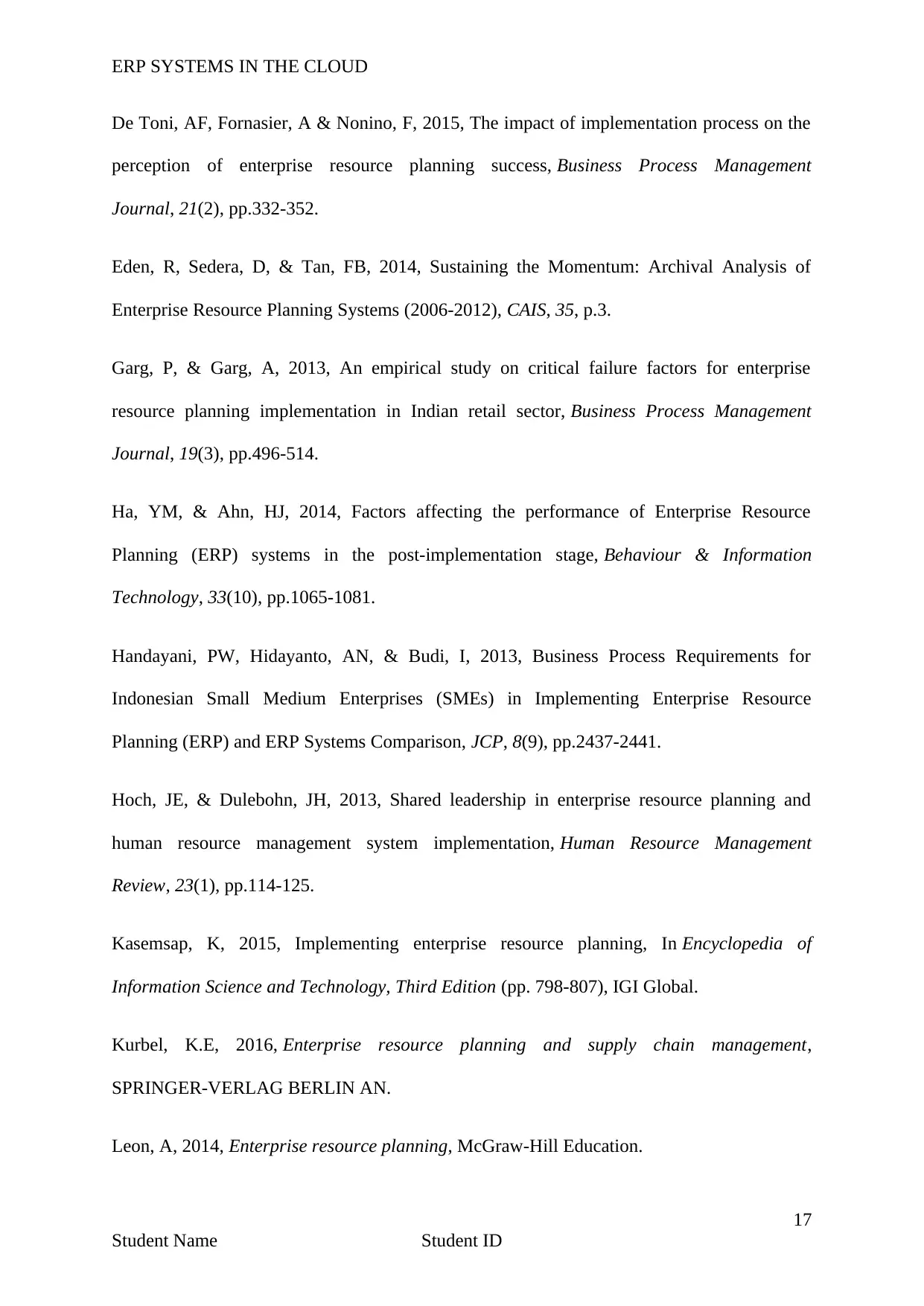
ERP SYSTEMS IN THE CLOUD
De Toni, AF, Fornasier, A & Nonino, F, 2015, The impact of implementation process on the
perception of enterprise resource planning success, Business Process Management
Journal, 21(2), pp.332-352.
Eden, R, Sedera, D, & Tan, FB, 2014, Sustaining the Momentum: Archival Analysis of
Enterprise Resource Planning Systems (2006-2012), CAIS, 35, p.3.
Garg, P, & Garg, A, 2013, An empirical study on critical failure factors for enterprise
resource planning implementation in Indian retail sector, Business Process Management
Journal, 19(3), pp.496-514.
Ha, YM, & Ahn, HJ, 2014, Factors affecting the performance of Enterprise Resource
Planning (ERP) systems in the post-implementation stage, Behaviour & Information
Technology, 33(10), pp.1065-1081.
Handayani, PW, Hidayanto, AN, & Budi, I, 2013, Business Process Requirements for
Indonesian Small Medium Enterprises (SMEs) in Implementing Enterprise Resource
Planning (ERP) and ERP Systems Comparison, JCP, 8(9), pp.2437-2441.
Hoch, JE, & Dulebohn, JH, 2013, Shared leadership in enterprise resource planning and
human resource management system implementation, Human Resource Management
Review, 23(1), pp.114-125.
Kasemsap, K, 2015, Implementing enterprise resource planning, In Encyclopedia of
Information Science and Technology, Third Edition (pp. 798-807), IGI Global.
Kurbel, K.E, 2016, Enterprise resource planning and supply chain management,
SPRINGER-VERLAG BERLIN AN.
Leon, A, 2014, Enterprise resource planning, McGraw-Hill Education.
17
Student Name Student ID
De Toni, AF, Fornasier, A & Nonino, F, 2015, The impact of implementation process on the
perception of enterprise resource planning success, Business Process Management
Journal, 21(2), pp.332-352.
Eden, R, Sedera, D, & Tan, FB, 2014, Sustaining the Momentum: Archival Analysis of
Enterprise Resource Planning Systems (2006-2012), CAIS, 35, p.3.
Garg, P, & Garg, A, 2013, An empirical study on critical failure factors for enterprise
resource planning implementation in Indian retail sector, Business Process Management
Journal, 19(3), pp.496-514.
Ha, YM, & Ahn, HJ, 2014, Factors affecting the performance of Enterprise Resource
Planning (ERP) systems in the post-implementation stage, Behaviour & Information
Technology, 33(10), pp.1065-1081.
Handayani, PW, Hidayanto, AN, & Budi, I, 2013, Business Process Requirements for
Indonesian Small Medium Enterprises (SMEs) in Implementing Enterprise Resource
Planning (ERP) and ERP Systems Comparison, JCP, 8(9), pp.2437-2441.
Hoch, JE, & Dulebohn, JH, 2013, Shared leadership in enterprise resource planning and
human resource management system implementation, Human Resource Management
Review, 23(1), pp.114-125.
Kasemsap, K, 2015, Implementing enterprise resource planning, In Encyclopedia of
Information Science and Technology, Third Edition (pp. 798-807), IGI Global.
Kurbel, K.E, 2016, Enterprise resource planning and supply chain management,
SPRINGER-VERLAG BERLIN AN.
Leon, A, 2014, Enterprise resource planning, McGraw-Hill Education.
17
Student Name Student ID
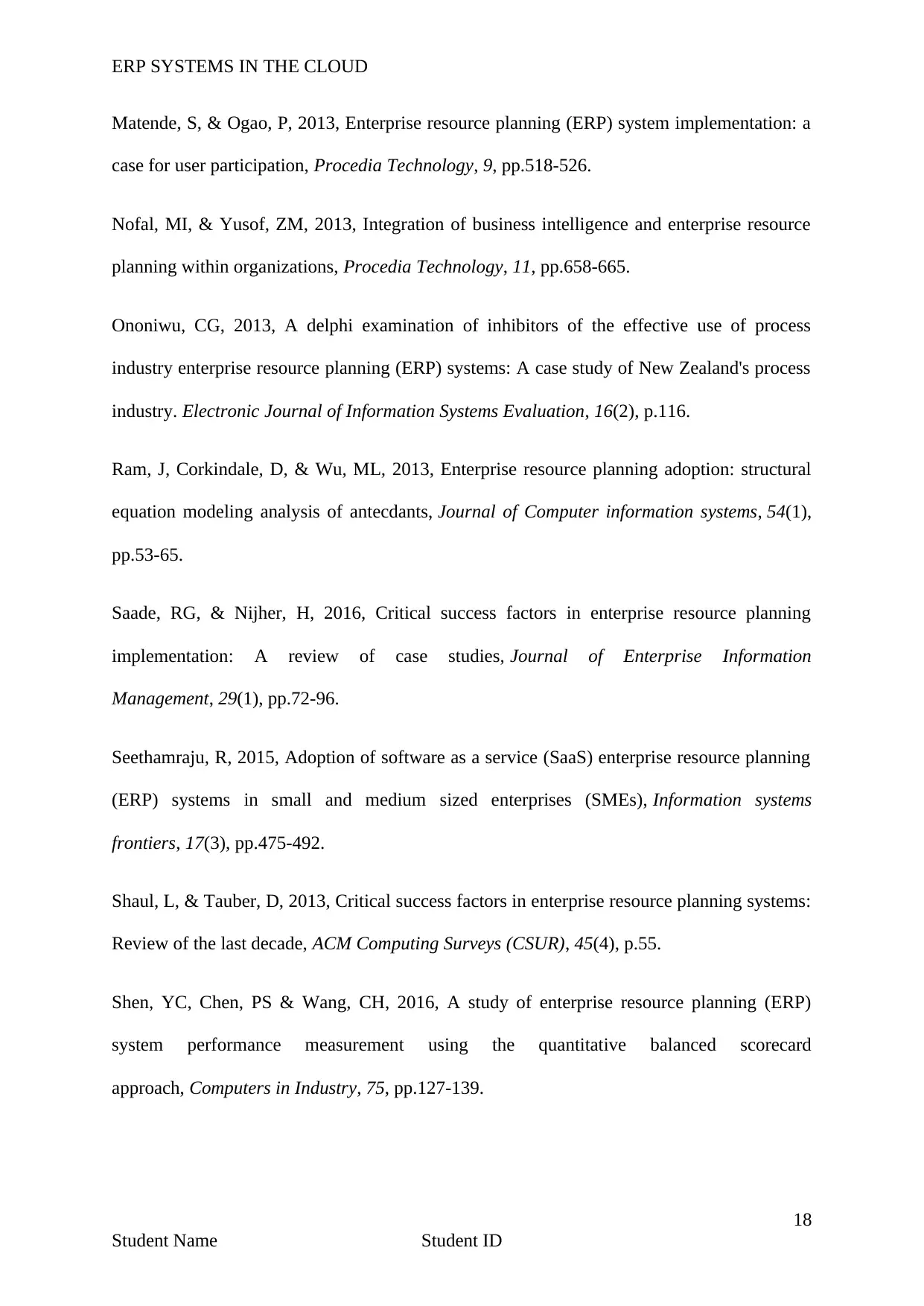
ERP SYSTEMS IN THE CLOUD
Matende, S, & Ogao, P, 2013, Enterprise resource planning (ERP) system implementation: a
case for user participation, Procedia Technology, 9, pp.518-526.
Nofal, MI, & Yusof, ZM, 2013, Integration of business intelligence and enterprise resource
planning within organizations, Procedia Technology, 11, pp.658-665.
Ononiwu, CG, 2013, A delphi examination of inhibitors of the effective use of process
industry enterprise resource planning (ERP) systems: A case study of New Zealand's process
industry. Electronic Journal of Information Systems Evaluation, 16(2), p.116.
Ram, J, Corkindale, D, & Wu, ML, 2013, Enterprise resource planning adoption: structural
equation modeling analysis of antecdants, Journal of Computer information systems, 54(1),
pp.53-65.
Saade, RG, & Nijher, H, 2016, Critical success factors in enterprise resource planning
implementation: A review of case studies, Journal of Enterprise Information
Management, 29(1), pp.72-96.
Seethamraju, R, 2015, Adoption of software as a service (SaaS) enterprise resource planning
(ERP) systems in small and medium sized enterprises (SMEs), Information systems
frontiers, 17(3), pp.475-492.
Shaul, L, & Tauber, D, 2013, Critical success factors in enterprise resource planning systems:
Review of the last decade, ACM Computing Surveys (CSUR), 45(4), p.55.
Shen, YC, Chen, PS & Wang, CH, 2016, A study of enterprise resource planning (ERP)
system performance measurement using the quantitative balanced scorecard
approach, Computers in Industry, 75, pp.127-139.
18
Student Name Student ID
Matende, S, & Ogao, P, 2013, Enterprise resource planning (ERP) system implementation: a
case for user participation, Procedia Technology, 9, pp.518-526.
Nofal, MI, & Yusof, ZM, 2013, Integration of business intelligence and enterprise resource
planning within organizations, Procedia Technology, 11, pp.658-665.
Ononiwu, CG, 2013, A delphi examination of inhibitors of the effective use of process
industry enterprise resource planning (ERP) systems: A case study of New Zealand's process
industry. Electronic Journal of Information Systems Evaluation, 16(2), p.116.
Ram, J, Corkindale, D, & Wu, ML, 2013, Enterprise resource planning adoption: structural
equation modeling analysis of antecdants, Journal of Computer information systems, 54(1),
pp.53-65.
Saade, RG, & Nijher, H, 2016, Critical success factors in enterprise resource planning
implementation: A review of case studies, Journal of Enterprise Information
Management, 29(1), pp.72-96.
Seethamraju, R, 2015, Adoption of software as a service (SaaS) enterprise resource planning
(ERP) systems in small and medium sized enterprises (SMEs), Information systems
frontiers, 17(3), pp.475-492.
Shaul, L, & Tauber, D, 2013, Critical success factors in enterprise resource planning systems:
Review of the last decade, ACM Computing Surveys (CSUR), 45(4), p.55.
Shen, YC, Chen, PS & Wang, CH, 2016, A study of enterprise resource planning (ERP)
system performance measurement using the quantitative balanced scorecard
approach, Computers in Industry, 75, pp.127-139.
18
Student Name Student ID
Paraphrase This Document
Need a fresh take? Get an instant paraphrase of this document with our AI Paraphraser
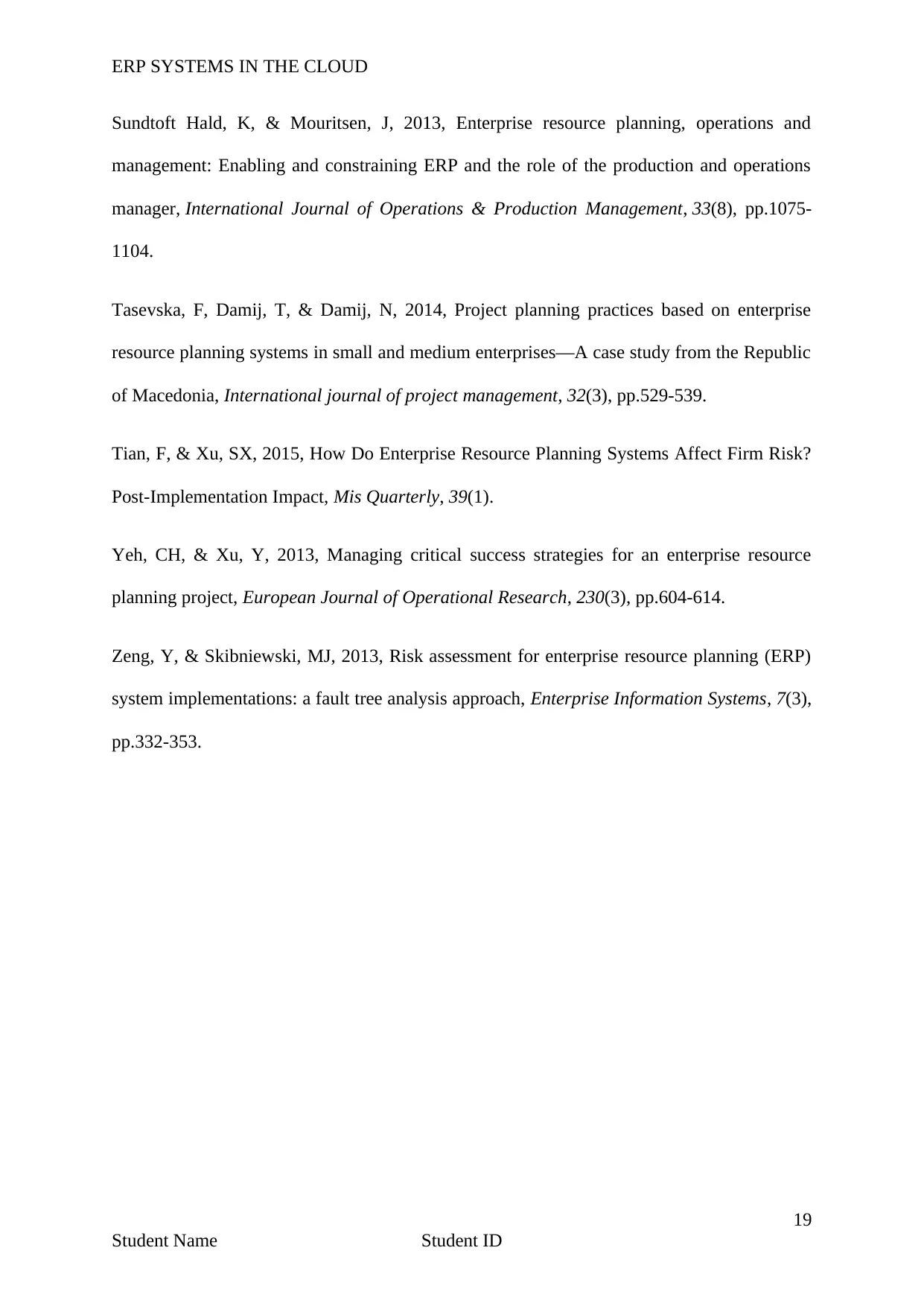
ERP SYSTEMS IN THE CLOUD
Sundtoft Hald, K, & Mouritsen, J, 2013, Enterprise resource planning, operations and
management: Enabling and constraining ERP and the role of the production and operations
manager, International Journal of Operations & Production Management, 33(8), pp.1075-
1104.
Tasevska, F, Damij, T, & Damij, N, 2014, Project planning practices based on enterprise
resource planning systems in small and medium enterprises—A case study from the Republic
of Macedonia, International journal of project management, 32(3), pp.529-539.
Tian, F, & Xu, SX, 2015, How Do Enterprise Resource Planning Systems Affect Firm Risk?
Post-Implementation Impact, Mis Quarterly, 39(1).
Yeh, CH, & Xu, Y, 2013, Managing critical success strategies for an enterprise resource
planning project, European Journal of Operational Research, 230(3), pp.604-614.
Zeng, Y, & Skibniewski, MJ, 2013, Risk assessment for enterprise resource planning (ERP)
system implementations: a fault tree analysis approach, Enterprise Information Systems, 7(3),
pp.332-353.
19
Student Name Student ID
Sundtoft Hald, K, & Mouritsen, J, 2013, Enterprise resource planning, operations and
management: Enabling and constraining ERP and the role of the production and operations
manager, International Journal of Operations & Production Management, 33(8), pp.1075-
1104.
Tasevska, F, Damij, T, & Damij, N, 2014, Project planning practices based on enterprise
resource planning systems in small and medium enterprises—A case study from the Republic
of Macedonia, International journal of project management, 32(3), pp.529-539.
Tian, F, & Xu, SX, 2015, How Do Enterprise Resource Planning Systems Affect Firm Risk?
Post-Implementation Impact, Mis Quarterly, 39(1).
Yeh, CH, & Xu, Y, 2013, Managing critical success strategies for an enterprise resource
planning project, European Journal of Operational Research, 230(3), pp.604-614.
Zeng, Y, & Skibniewski, MJ, 2013, Risk assessment for enterprise resource planning (ERP)
system implementations: a fault tree analysis approach, Enterprise Information Systems, 7(3),
pp.332-353.
19
Student Name Student ID
1 out of 20
Related Documents
Your All-in-One AI-Powered Toolkit for Academic Success.
+13062052269
info@desklib.com
Available 24*7 on WhatsApp / Email
![[object Object]](/_next/static/media/star-bottom.7253800d.svg)
Unlock your academic potential
© 2024 | Zucol Services PVT LTD | All rights reserved.





